Challenges and Opportunities of Implementing ERP in Small and Medium Enterprises (SMEs)
VerifiedAdded on 2023/04/23
|18
|4495
|359
AI Summary
This report discusses the challenges and opportunities of implementing ERP in small and medium enterprises (SMEs). It covers the ERP implementation process, benefits, and challenges. The report also includes a real-life case study for better understanding.
Contribute Materials
Your contribution can guide someone’s learning journey. Share your
documents today.
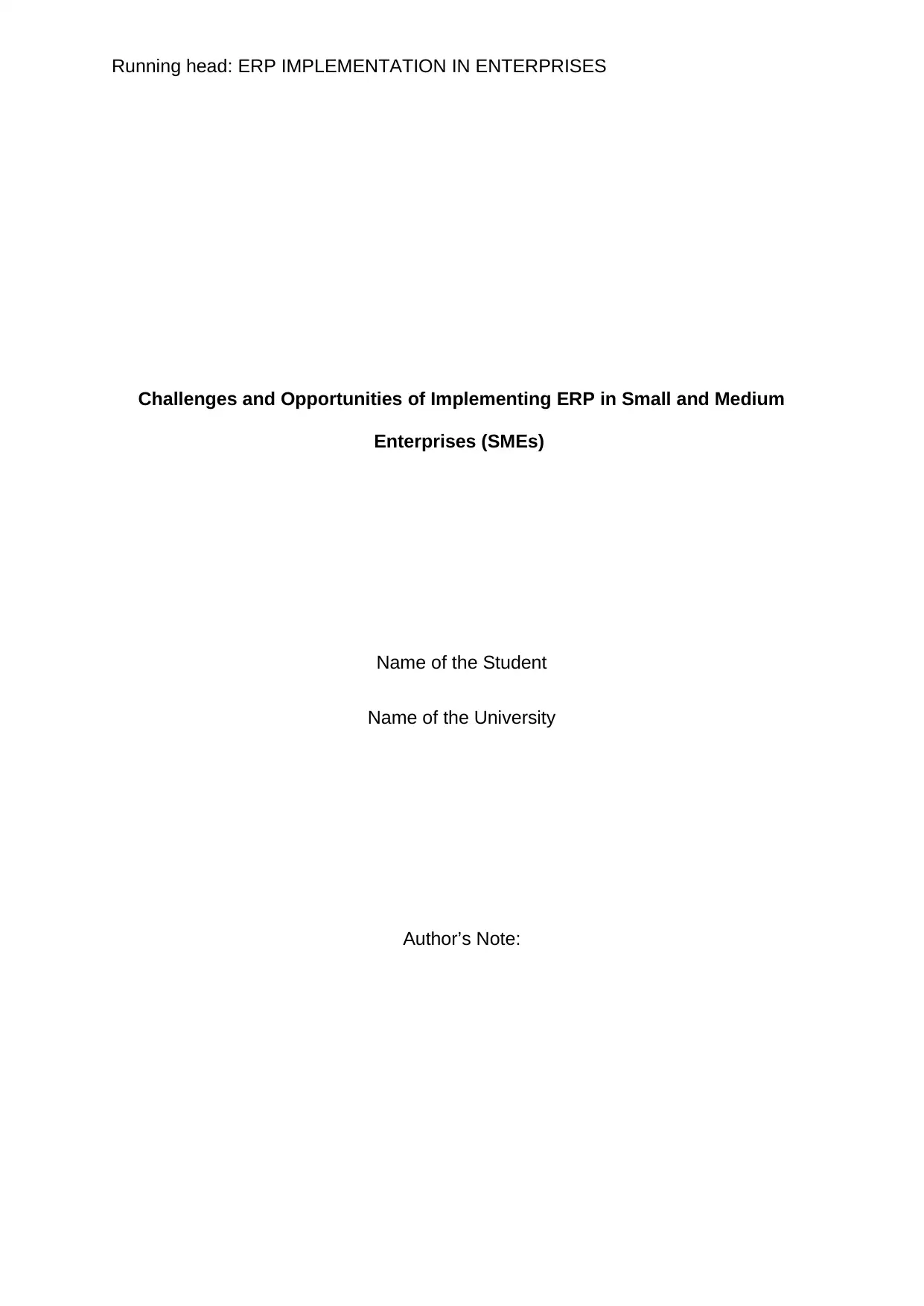
Running head: ERP IMPLEMENTATION IN ENTERPRISES
Challenges and Opportunities of Implementing ERP in Small and Medium
Enterprises (SMEs)
Name of the Student
Name of the University
Author’s Note:
Challenges and Opportunities of Implementing ERP in Small and Medium
Enterprises (SMEs)
Name of the Student
Name of the University
Author’s Note:
Secure Best Marks with AI Grader
Need help grading? Try our AI Grader for instant feedback on your assignments.
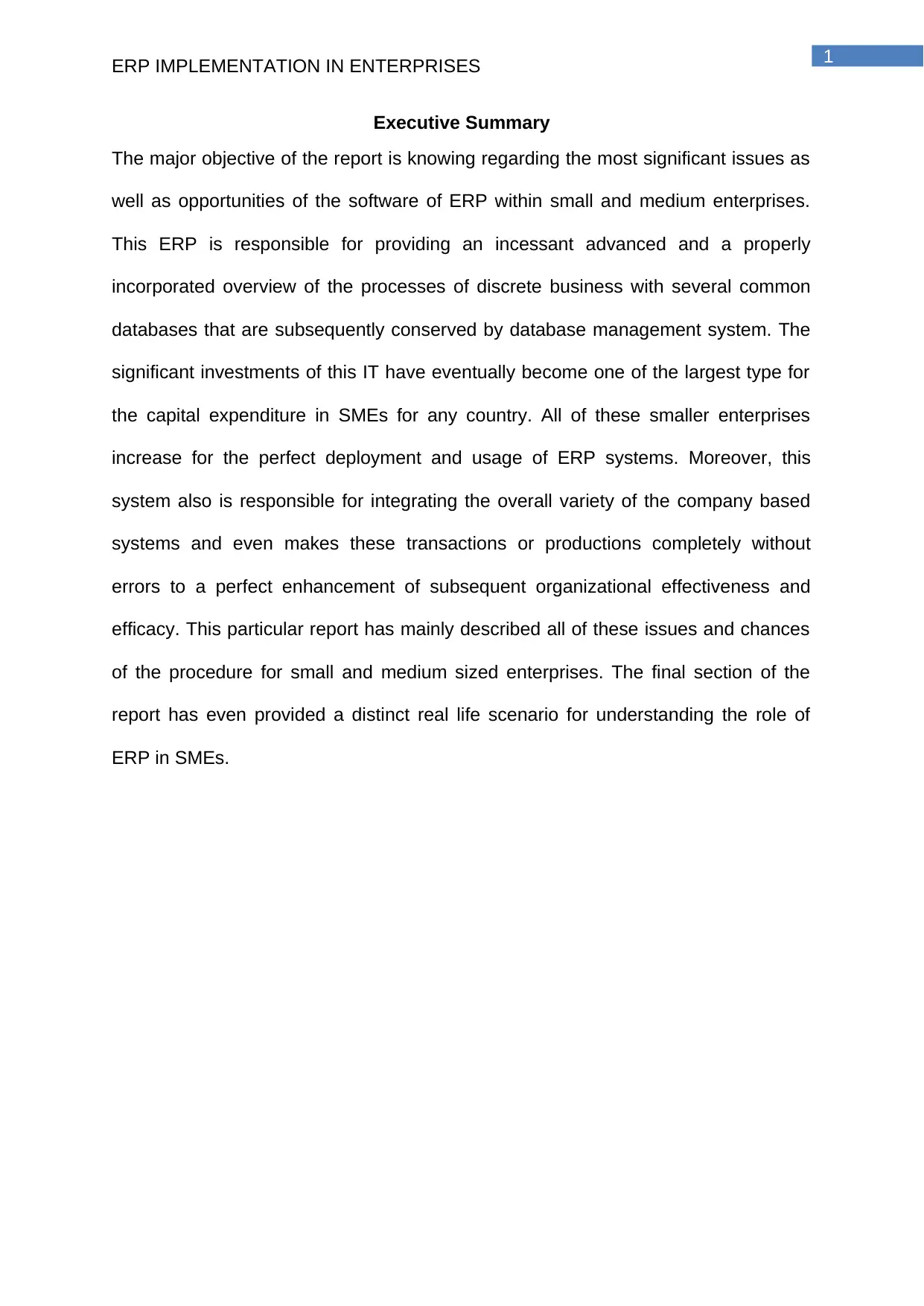
1
ERP IMPLEMENTATION IN ENTERPRISES
Executive Summary
The major objective of the report is knowing regarding the most significant issues as
well as opportunities of the software of ERP within small and medium enterprises.
This ERP is responsible for providing an incessant advanced and a properly
incorporated overview of the processes of discrete business with several common
databases that are subsequently conserved by database management system. The
significant investments of this IT have eventually become one of the largest type for
the capital expenditure in SMEs for any country. All of these smaller enterprises
increase for the perfect deployment and usage of ERP systems. Moreover, this
system also is responsible for integrating the overall variety of the company based
systems and even makes these transactions or productions completely without
errors to a perfect enhancement of subsequent organizational effectiveness and
efficacy. This particular report has mainly described all of these issues and chances
of the procedure for small and medium sized enterprises. The final section of the
report has even provided a distinct real life scenario for understanding the role of
ERP in SMEs.
ERP IMPLEMENTATION IN ENTERPRISES
Executive Summary
The major objective of the report is knowing regarding the most significant issues as
well as opportunities of the software of ERP within small and medium enterprises.
This ERP is responsible for providing an incessant advanced and a properly
incorporated overview of the processes of discrete business with several common
databases that are subsequently conserved by database management system. The
significant investments of this IT have eventually become one of the largest type for
the capital expenditure in SMEs for any country. All of these smaller enterprises
increase for the perfect deployment and usage of ERP systems. Moreover, this
system also is responsible for integrating the overall variety of the company based
systems and even makes these transactions or productions completely without
errors to a perfect enhancement of subsequent organizational effectiveness and
efficacy. This particular report has mainly described all of these issues and chances
of the procedure for small and medium sized enterprises. The final section of the
report has even provided a distinct real life scenario for understanding the role of
ERP in SMEs.
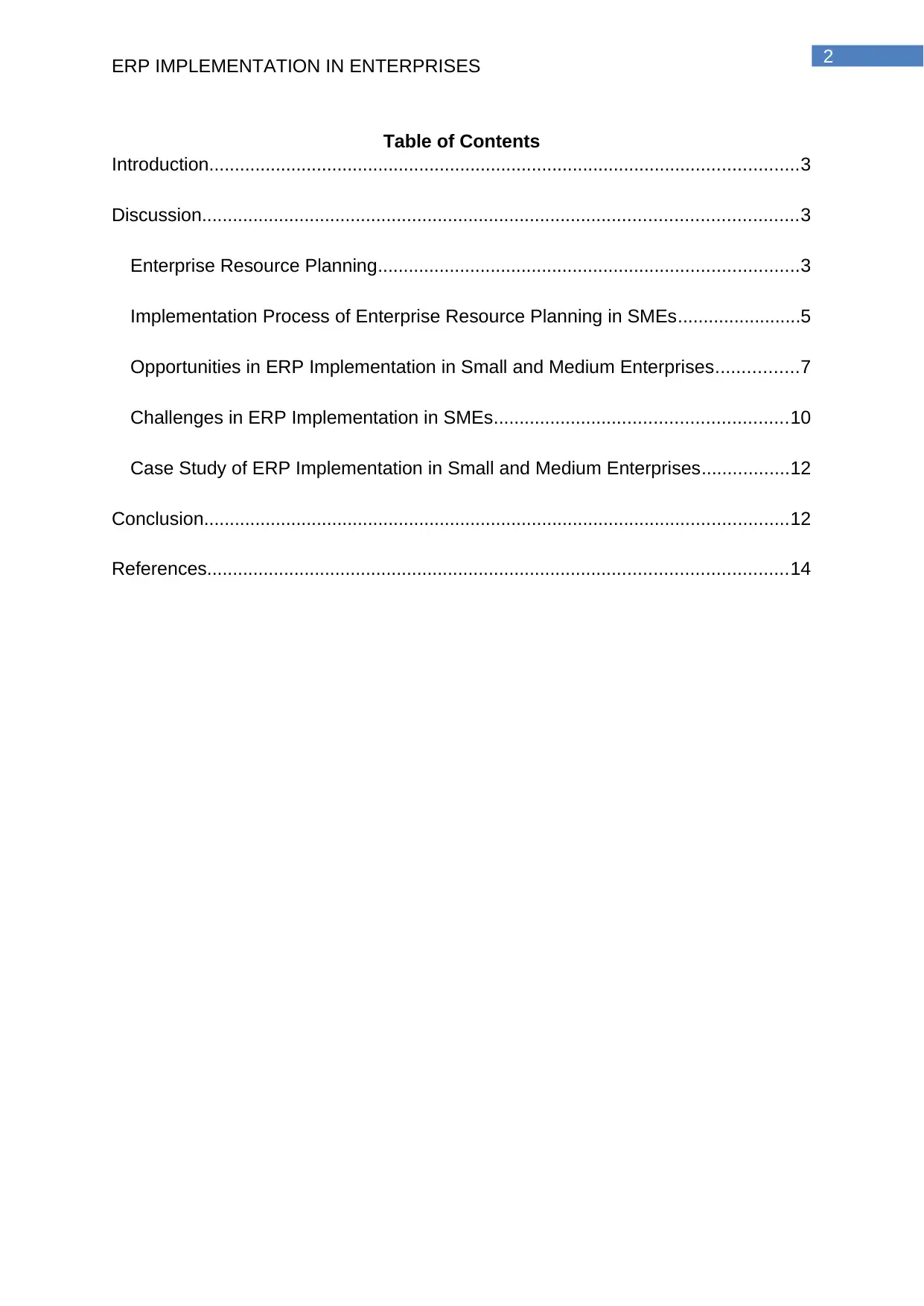
2
ERP IMPLEMENTATION IN ENTERPRISES
Table of Contents
Introduction...................................................................................................................3
Discussion....................................................................................................................3
Enterprise Resource Planning..................................................................................3
Implementation Process of Enterprise Resource Planning in SMEs........................5
Opportunities in ERP Implementation in Small and Medium Enterprises................7
Challenges in ERP Implementation in SMEs.........................................................10
Case Study of ERP Implementation in Small and Medium Enterprises.................12
Conclusion..................................................................................................................12
References.................................................................................................................14
ERP IMPLEMENTATION IN ENTERPRISES
Table of Contents
Introduction...................................................................................................................3
Discussion....................................................................................................................3
Enterprise Resource Planning..................................................................................3
Implementation Process of Enterprise Resource Planning in SMEs........................5
Opportunities in ERP Implementation in Small and Medium Enterprises................7
Challenges in ERP Implementation in SMEs.........................................................10
Case Study of ERP Implementation in Small and Medium Enterprises.................12
Conclusion..................................................................................................................12
References.................................................................................................................14
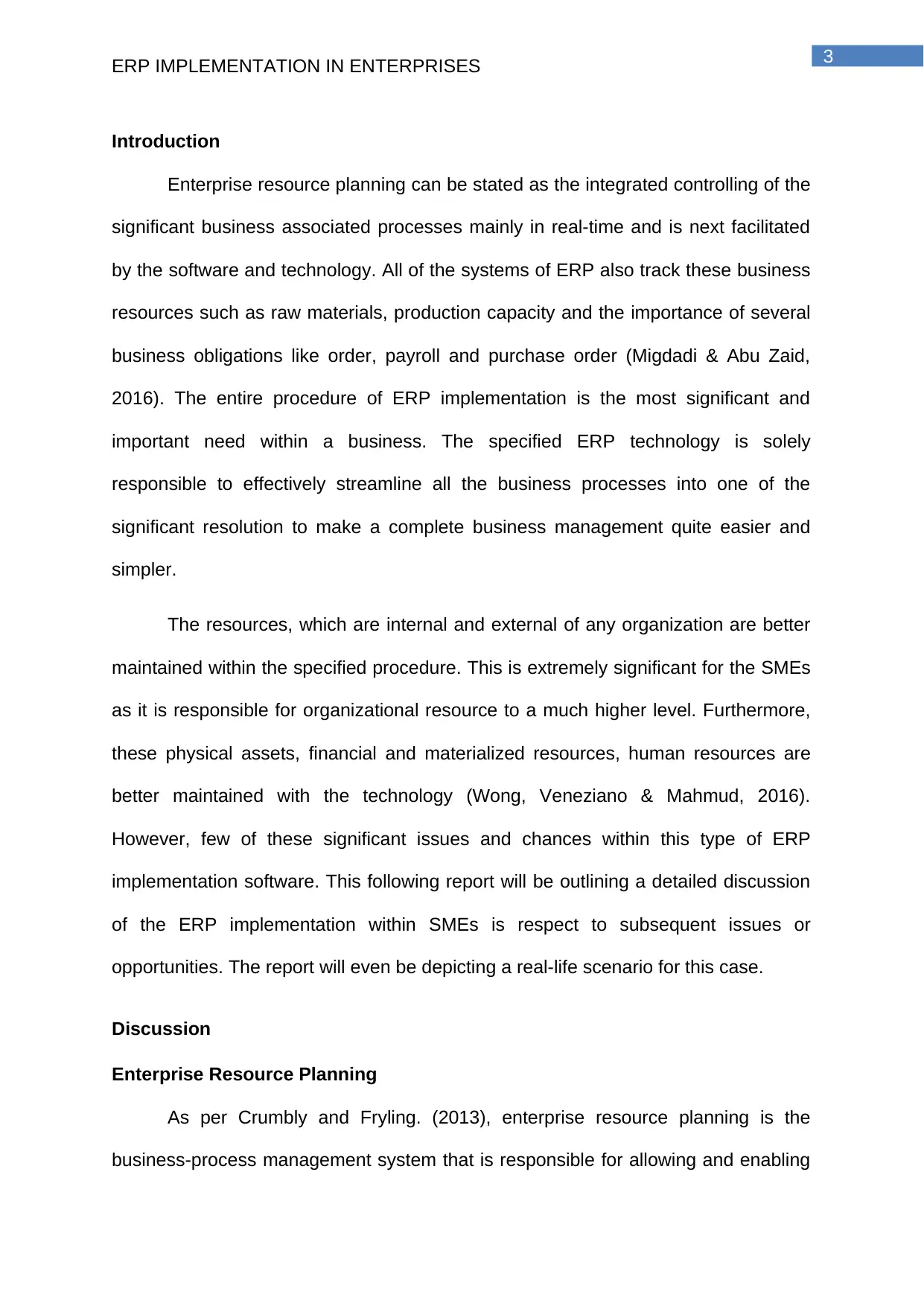
3
ERP IMPLEMENTATION IN ENTERPRISES
Introduction
Enterprise resource planning can be stated as the integrated controlling of the
significant business associated processes mainly in real-time and is next facilitated
by the software and technology. All of the systems of ERP also track these business
resources such as raw materials, production capacity and the importance of several
business obligations like order, payroll and purchase order (Migdadi & Abu Zaid,
2016). The entire procedure of ERP implementation is the most significant and
important need within a business. The specified ERP technology is solely
responsible to effectively streamline all the business processes into one of the
significant resolution to make a complete business management quite easier and
simpler.
The resources, which are internal and external of any organization are better
maintained within the specified procedure. This is extremely significant for the SMEs
as it is responsible for organizational resource to a much higher level. Furthermore,
these physical assets, financial and materialized resources, human resources are
better maintained with the technology (Wong, Veneziano & Mahmud, 2016).
However, few of these significant issues and chances within this type of ERP
implementation software. This following report will be outlining a detailed discussion
of the ERP implementation within SMEs is respect to subsequent issues or
opportunities. The report will even be depicting a real-life scenario for this case.
Discussion
Enterprise Resource Planning
As per Crumbly and Fryling. (2013), enterprise resource planning is the
business-process management system that is responsible for allowing and enabling
ERP IMPLEMENTATION IN ENTERPRISES
Introduction
Enterprise resource planning can be stated as the integrated controlling of the
significant business associated processes mainly in real-time and is next facilitated
by the software and technology. All of the systems of ERP also track these business
resources such as raw materials, production capacity and the importance of several
business obligations like order, payroll and purchase order (Migdadi & Abu Zaid,
2016). The entire procedure of ERP implementation is the most significant and
important need within a business. The specified ERP technology is solely
responsible to effectively streamline all the business processes into one of the
significant resolution to make a complete business management quite easier and
simpler.
The resources, which are internal and external of any organization are better
maintained within the specified procedure. This is extremely significant for the SMEs
as it is responsible for organizational resource to a much higher level. Furthermore,
these physical assets, financial and materialized resources, human resources are
better maintained with the technology (Wong, Veneziano & Mahmud, 2016).
However, few of these significant issues and chances within this type of ERP
implementation software. This following report will be outlining a detailed discussion
of the ERP implementation within SMEs is respect to subsequent issues or
opportunities. The report will even be depicting a real-life scenario for this case.
Discussion
Enterprise Resource Planning
As per Crumbly and Fryling. (2013), enterprise resource planning is the
business-process management system that is responsible for allowing and enabling
Secure Best Marks with AI Grader
Need help grading? Try our AI Grader for instant feedback on your assignments.
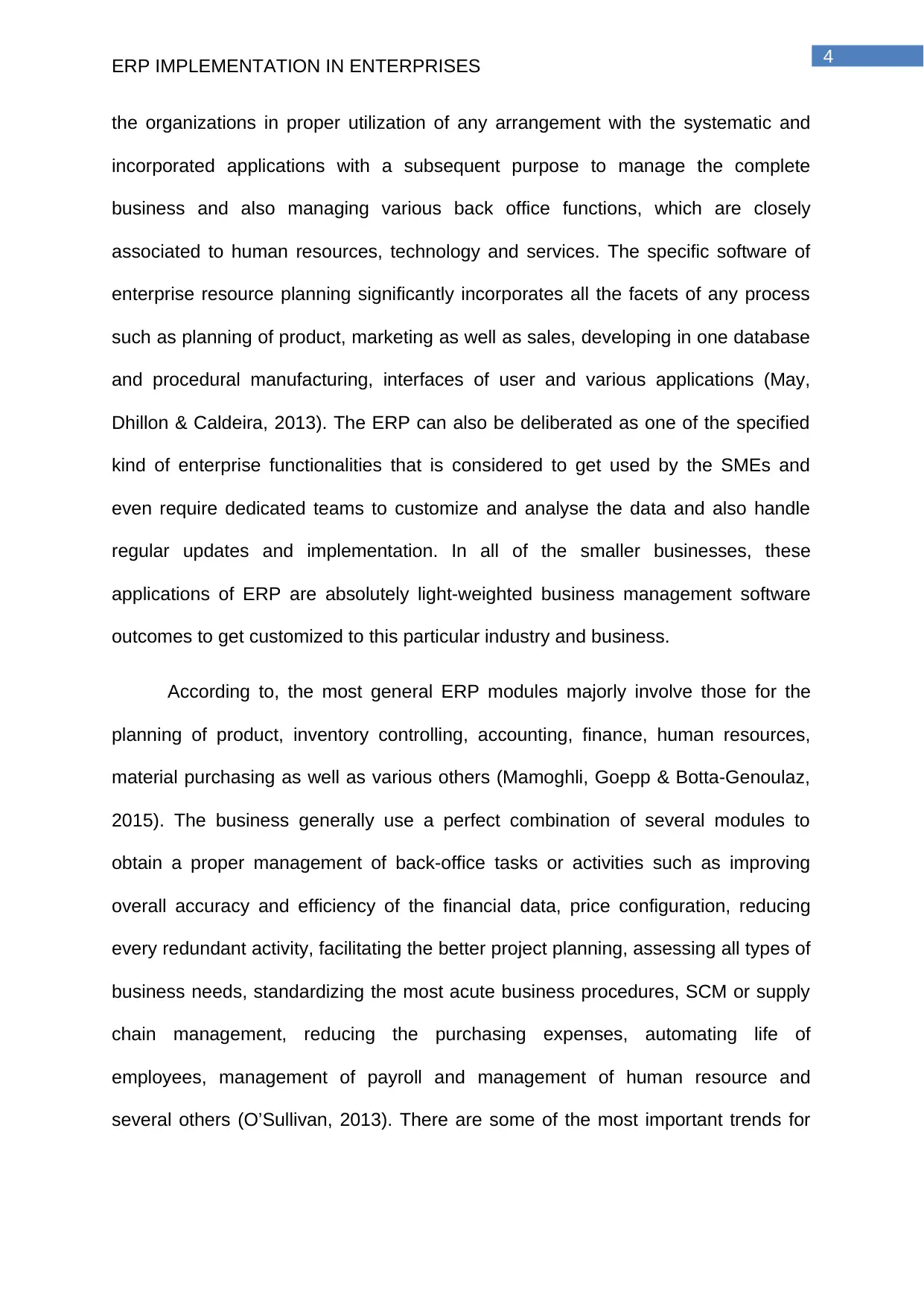
4
ERP IMPLEMENTATION IN ENTERPRISES
the organizations in proper utilization of any arrangement with the systematic and
incorporated applications with a subsequent purpose to manage the complete
business and also managing various back office functions, which are closely
associated to human resources, technology and services. The specific software of
enterprise resource planning significantly incorporates all the facets of any process
such as planning of product, marketing as well as sales, developing in one database
and procedural manufacturing, interfaces of user and various applications (May,
Dhillon & Caldeira, 2013). The ERP can also be deliberated as one of the specified
kind of enterprise functionalities that is considered to get used by the SMEs and
even require dedicated teams to customize and analyse the data and also handle
regular updates and implementation. In all of the smaller businesses, these
applications of ERP are absolutely light-weighted business management software
outcomes to get customized to this particular industry and business.
According to, the most general ERP modules majorly involve those for the
planning of product, inventory controlling, accounting, finance, human resources,
material purchasing as well as various others (Mamoghli, Goepp & Botta-Genoulaz,
2015). The business generally use a perfect combination of several modules to
obtain a proper management of back-office tasks or activities such as improving
overall accuracy and efficiency of the financial data, price configuration, reducing
every redundant activity, facilitating the better project planning, assessing all types of
business needs, standardizing the most acute business procedures, SCM or supply
chain management, reducing the purchasing expenses, automating life of
employees, management of payroll and management of human resource and
several others (O’Sullivan, 2013). There are some of the most important trends for
ERP IMPLEMENTATION IN ENTERPRISES
the organizations in proper utilization of any arrangement with the systematic and
incorporated applications with a subsequent purpose to manage the complete
business and also managing various back office functions, which are closely
associated to human resources, technology and services. The specific software of
enterprise resource planning significantly incorporates all the facets of any process
such as planning of product, marketing as well as sales, developing in one database
and procedural manufacturing, interfaces of user and various applications (May,
Dhillon & Caldeira, 2013). The ERP can also be deliberated as one of the specified
kind of enterprise functionalities that is considered to get used by the SMEs and
even require dedicated teams to customize and analyse the data and also handle
regular updates and implementation. In all of the smaller businesses, these
applications of ERP are absolutely light-weighted business management software
outcomes to get customized to this particular industry and business.
According to, the most general ERP modules majorly involve those for the
planning of product, inventory controlling, accounting, finance, human resources,
material purchasing as well as various others (Mamoghli, Goepp & Botta-Genoulaz,
2015). The business generally use a perfect combination of several modules to
obtain a proper management of back-office tasks or activities such as improving
overall accuracy and efficiency of the financial data, price configuration, reducing
every redundant activity, facilitating the better project planning, assessing all types of
business needs, standardizing the most acute business procedures, SCM or supply
chain management, reducing the purchasing expenses, automating life of
employees, management of payroll and management of human resource and
several others (O’Sullivan, 2013). There are some of the most important trends for
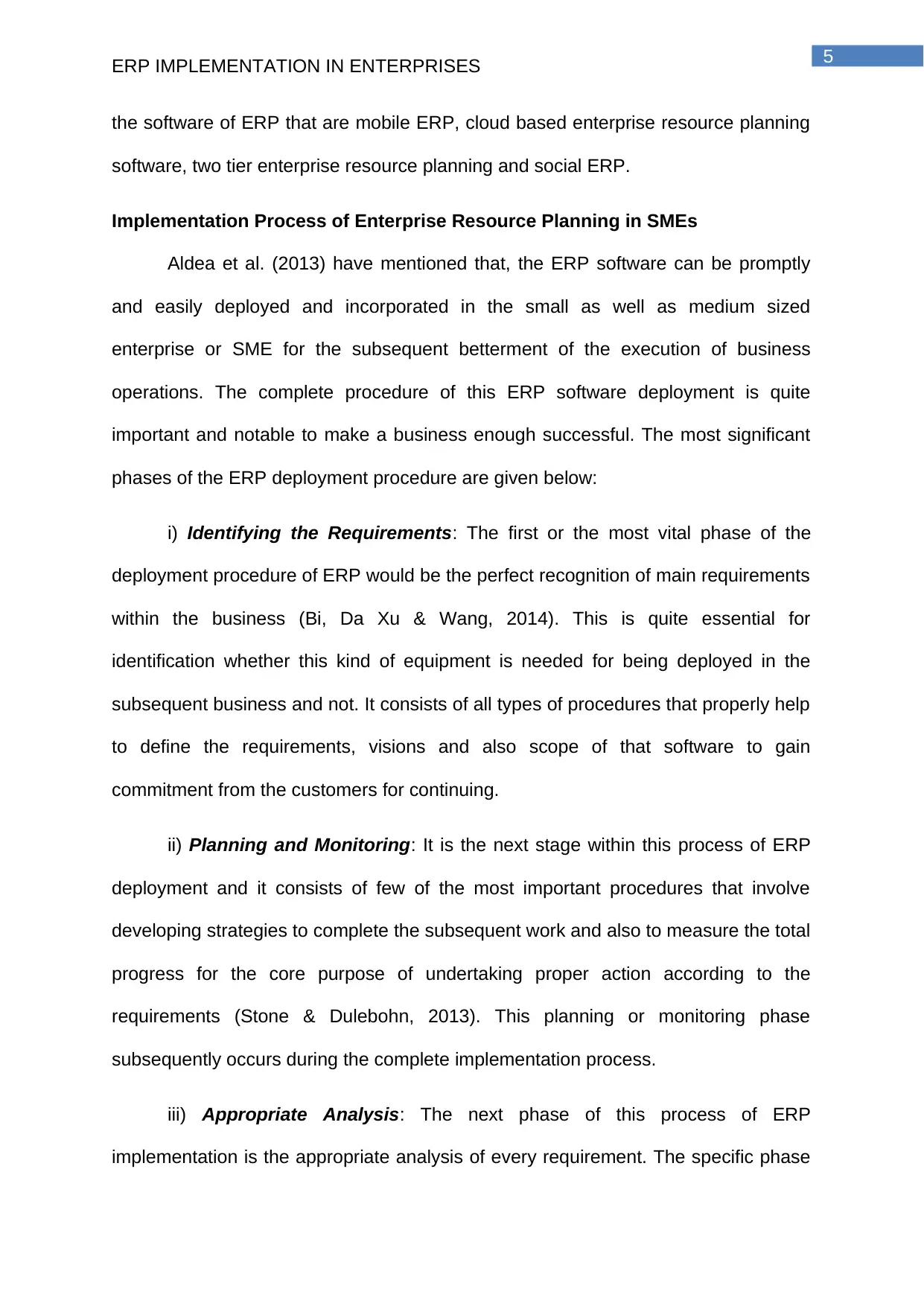
5
ERP IMPLEMENTATION IN ENTERPRISES
the software of ERP that are mobile ERP, cloud based enterprise resource planning
software, two tier enterprise resource planning and social ERP.
Implementation Process of Enterprise Resource Planning in SMEs
Aldea et al. (2013) have mentioned that, the ERP software can be promptly
and easily deployed and incorporated in the small as well as medium sized
enterprise or SME for the subsequent betterment of the execution of business
operations. The complete procedure of this ERP software deployment is quite
important and notable to make a business enough successful. The most significant
phases of the ERP deployment procedure are given below:
i) Identifying the Requirements: The first or the most vital phase of the
deployment procedure of ERP would be the perfect recognition of main requirements
within the business (Bi, Da Xu & Wang, 2014). This is quite essential for
identification whether this kind of equipment is needed for being deployed in the
subsequent business and not. It consists of all types of procedures that properly help
to define the requirements, visions and also scope of that software to gain
commitment from the customers for continuing.
ii) Planning and Monitoring: It is the next stage within this process of ERP
deployment and it consists of few of the most important procedures that involve
developing strategies to complete the subsequent work and also to measure the total
progress for the core purpose of undertaking proper action according to the
requirements (Stone & Dulebohn, 2013). This planning or monitoring phase
subsequently occurs during the complete implementation process.
iii) Appropriate Analysis: The next phase of this process of ERP
implementation is the appropriate analysis of every requirement. The specific phase
ERP IMPLEMENTATION IN ENTERPRISES
the software of ERP that are mobile ERP, cloud based enterprise resource planning
software, two tier enterprise resource planning and social ERP.
Implementation Process of Enterprise Resource Planning in SMEs
Aldea et al. (2013) have mentioned that, the ERP software can be promptly
and easily deployed and incorporated in the small as well as medium sized
enterprise or SME for the subsequent betterment of the execution of business
operations. The complete procedure of this ERP software deployment is quite
important and notable to make a business enough successful. The most significant
phases of the ERP deployment procedure are given below:
i) Identifying the Requirements: The first or the most vital phase of the
deployment procedure of ERP would be the perfect recognition of main requirements
within the business (Bi, Da Xu & Wang, 2014). This is quite essential for
identification whether this kind of equipment is needed for being deployed in the
subsequent business and not. It consists of all types of procedures that properly help
to define the requirements, visions and also scope of that software to gain
commitment from the customers for continuing.
ii) Planning and Monitoring: It is the next stage within this process of ERP
deployment and it consists of few of the most important procedures that involve
developing strategies to complete the subsequent work and also to measure the total
progress for the core purpose of undertaking proper action according to the
requirements (Stone & Dulebohn, 2013). This planning or monitoring phase
subsequently occurs during the complete implementation process.
iii) Appropriate Analysis: The next phase of this process of ERP
implementation is the appropriate analysis of every requirement. The specific phase
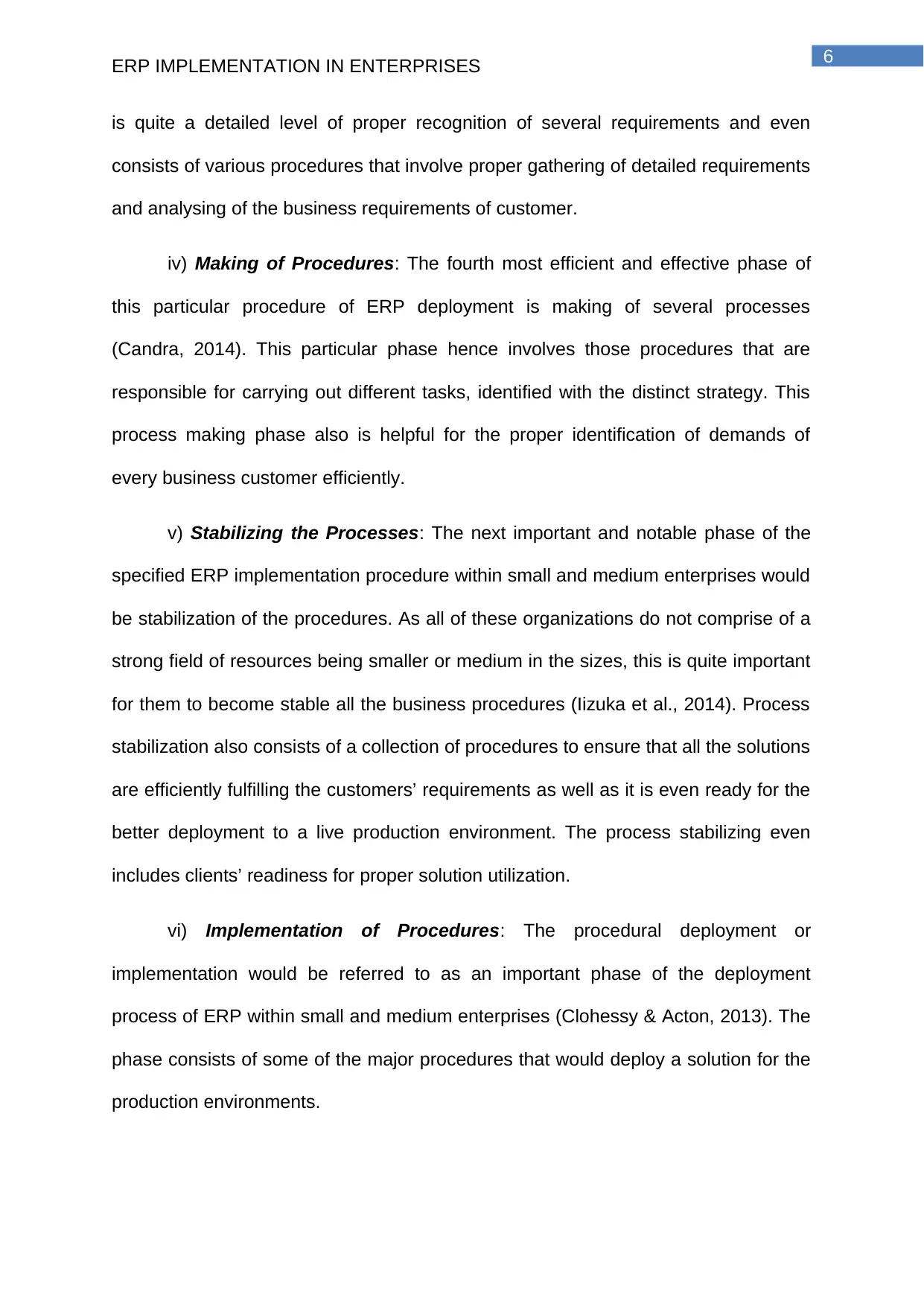
6
ERP IMPLEMENTATION IN ENTERPRISES
is quite a detailed level of proper recognition of several requirements and even
consists of various procedures that involve proper gathering of detailed requirements
and analysing of the business requirements of customer.
iv) Making of Procedures: The fourth most efficient and effective phase of
this particular procedure of ERP deployment is making of several processes
(Candra, 2014). This particular phase hence involves those procedures that are
responsible for carrying out different tasks, identified with the distinct strategy. This
process making phase also is helpful for the proper identification of demands of
every business customer efficiently.
v) Stabilizing the Processes: The next important and notable phase of the
specified ERP implementation procedure within small and medium enterprises would
be stabilization of the procedures. As all of these organizations do not comprise of a
strong field of resources being smaller or medium in the sizes, this is quite important
for them to become stable all the business procedures (Iizuka et al., 2014). Process
stabilization also consists of a collection of procedures to ensure that all the solutions
are efficiently fulfilling the customers’ requirements as well as it is even ready for the
better deployment to a live production environment. The process stabilizing even
includes clients’ readiness for proper solution utilization.
vi) Implementation of Procedures: The procedural deployment or
implementation would be referred to as an important phase of the deployment
process of ERP within small and medium enterprises (Clohessy & Acton, 2013). The
phase consists of some of the major procedures that would deploy a solution for the
production environments.
ERP IMPLEMENTATION IN ENTERPRISES
is quite a detailed level of proper recognition of several requirements and even
consists of various procedures that involve proper gathering of detailed requirements
and analysing of the business requirements of customer.
iv) Making of Procedures: The fourth most efficient and effective phase of
this particular procedure of ERP deployment is making of several processes
(Candra, 2014). This particular phase hence involves those procedures that are
responsible for carrying out different tasks, identified with the distinct strategy. This
process making phase also is helpful for the proper identification of demands of
every business customer efficiently.
v) Stabilizing the Processes: The next important and notable phase of the
specified ERP implementation procedure within small and medium enterprises would
be stabilization of the procedures. As all of these organizations do not comprise of a
strong field of resources being smaller or medium in the sizes, this is quite important
for them to become stable all the business procedures (Iizuka et al., 2014). Process
stabilization also consists of a collection of procedures to ensure that all the solutions
are efficiently fulfilling the customers’ requirements as well as it is even ready for the
better deployment to a live production environment. The process stabilizing even
includes clients’ readiness for proper solution utilization.
vi) Implementation of Procedures: The procedural deployment or
implementation would be referred to as an important phase of the deployment
process of ERP within small and medium enterprises (Clohessy & Acton, 2013). The
phase consists of some of the major procedures that would deploy a solution for the
production environments.
Paraphrase This Document
Need a fresh take? Get an instant paraphrase of this document with our AI Paraphraser
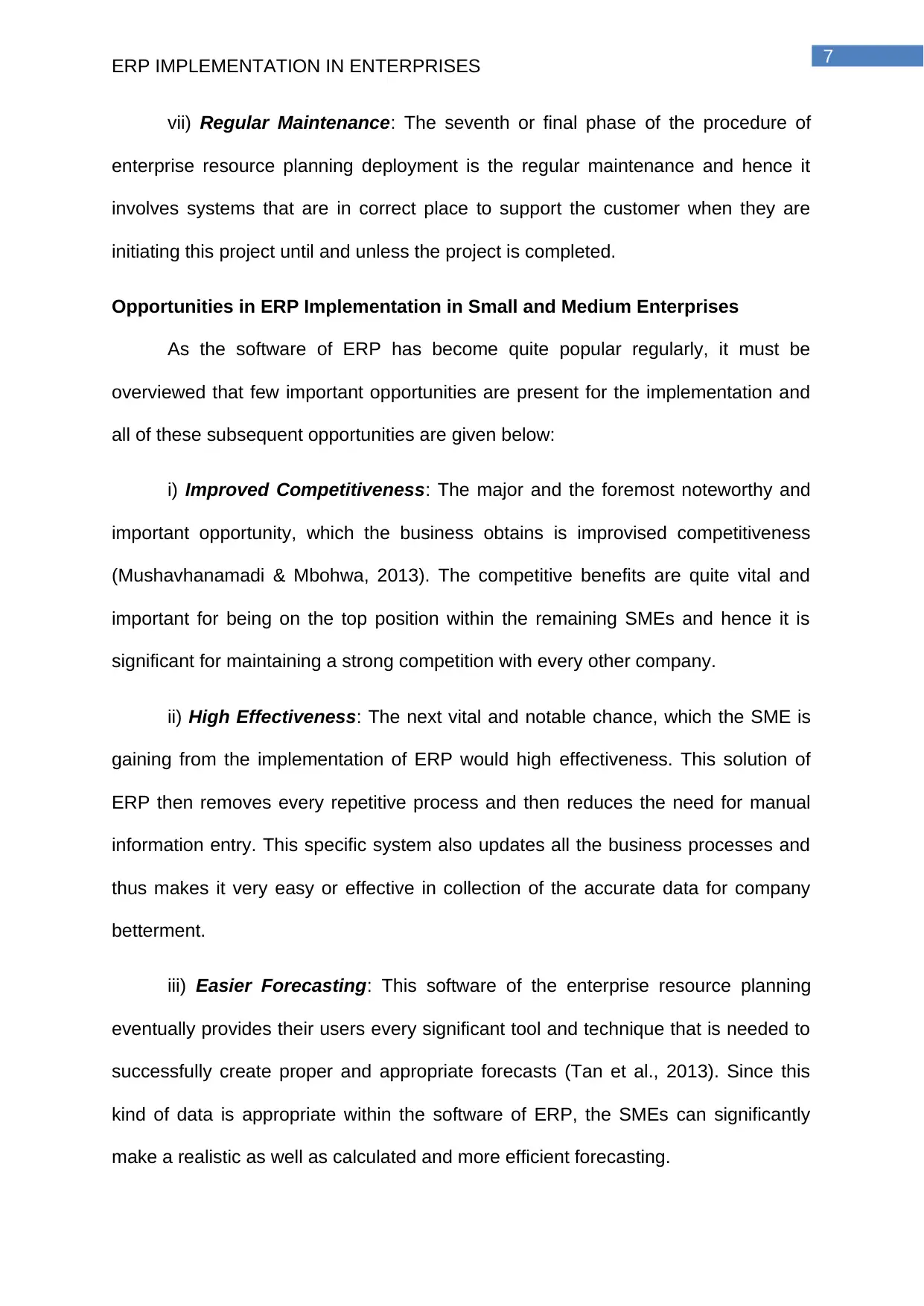
7
ERP IMPLEMENTATION IN ENTERPRISES
vii) Regular Maintenance: The seventh or final phase of the procedure of
enterprise resource planning deployment is the regular maintenance and hence it
involves systems that are in correct place to support the customer when they are
initiating this project until and unless the project is completed.
Opportunities in ERP Implementation in Small and Medium Enterprises
As the software of ERP has become quite popular regularly, it must be
overviewed that few important opportunities are present for the implementation and
all of these subsequent opportunities are given below:
i) Improved Competitiveness: The major and the foremost noteworthy and
important opportunity, which the business obtains is improvised competitiveness
(Mushavhanamadi & Mbohwa, 2013). The competitive benefits are quite vital and
important for being on the top position within the remaining SMEs and hence it is
significant for maintaining a strong competition with every other company.
ii) High Effectiveness: The next vital and notable chance, which the SME is
gaining from the implementation of ERP would high effectiveness. This solution of
ERP then removes every repetitive process and then reduces the need for manual
information entry. This specific system also updates all the business processes and
thus makes it very easy or effective in collection of the accurate data for company
betterment.
iii) Easier Forecasting: This software of the enterprise resource planning
eventually provides their users every significant tool and technique that is needed to
successfully create proper and appropriate forecasts (Tan et al., 2013). Since this
kind of data is appropriate within the software of ERP, the SMEs can significantly
make a realistic as well as calculated and more efficient forecasting.
ERP IMPLEMENTATION IN ENTERPRISES
vii) Regular Maintenance: The seventh or final phase of the procedure of
enterprise resource planning deployment is the regular maintenance and hence it
involves systems that are in correct place to support the customer when they are
initiating this project until and unless the project is completed.
Opportunities in ERP Implementation in Small and Medium Enterprises
As the software of ERP has become quite popular regularly, it must be
overviewed that few important opportunities are present for the implementation and
all of these subsequent opportunities are given below:
i) Improved Competitiveness: The major and the foremost noteworthy and
important opportunity, which the business obtains is improvised competitiveness
(Mushavhanamadi & Mbohwa, 2013). The competitive benefits are quite vital and
important for being on the top position within the remaining SMEs and hence it is
significant for maintaining a strong competition with every other company.
ii) High Effectiveness: The next vital and notable chance, which the SME is
gaining from the implementation of ERP would high effectiveness. This solution of
ERP then removes every repetitive process and then reduces the need for manual
information entry. This specific system also updates all the business processes and
thus makes it very easy or effective in collection of the accurate data for company
betterment.
iii) Easier Forecasting: This software of the enterprise resource planning
eventually provides their users every significant tool and technique that is needed to
successfully create proper and appropriate forecasts (Tan et al., 2013). Since this
kind of data is appropriate within the software of ERP, the SMEs can significantly
make a realistic as well as calculated and more efficient forecasting.
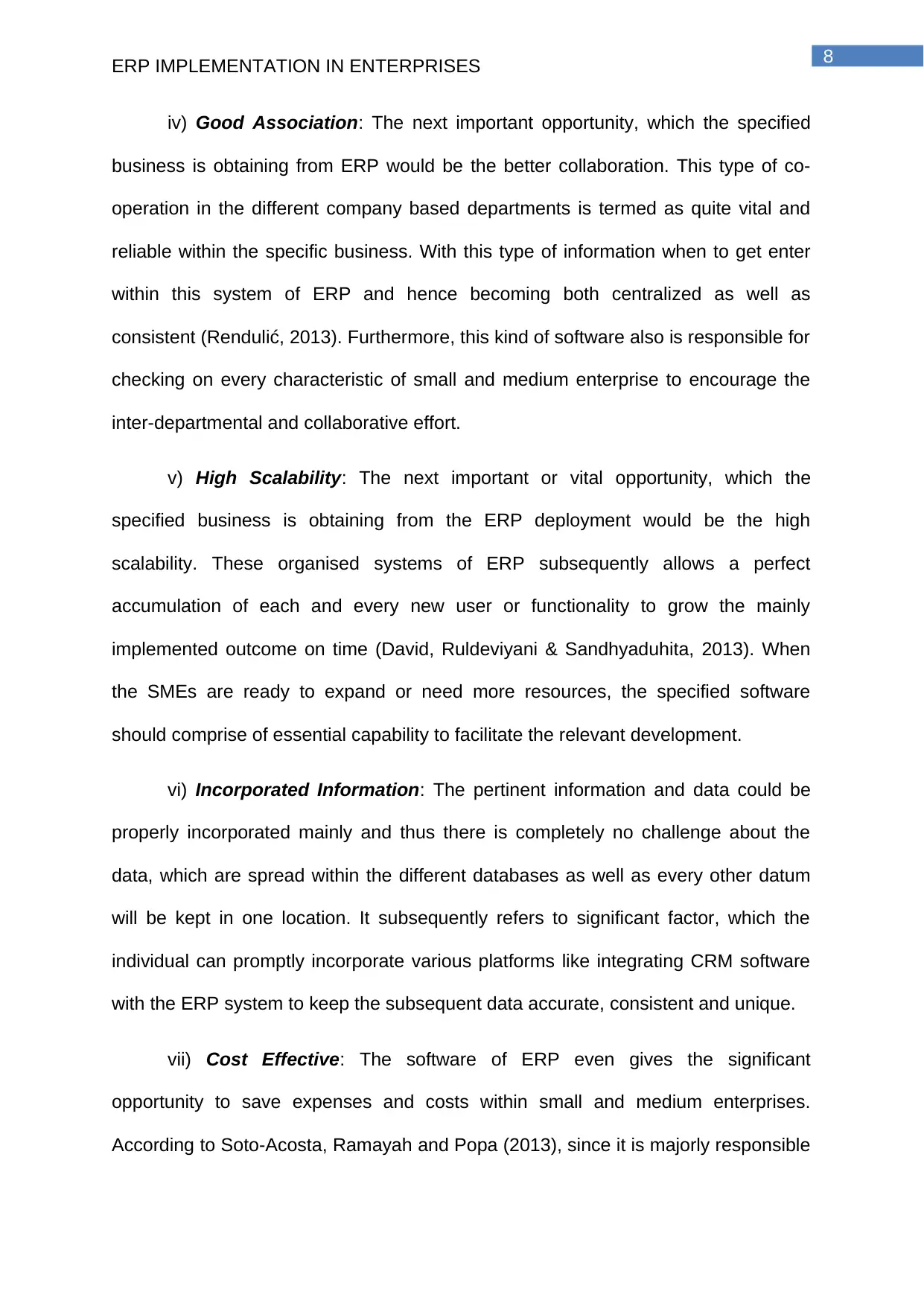
8
ERP IMPLEMENTATION IN ENTERPRISES
iv) Good Association: The next important opportunity, which the specified
business is obtaining from ERP would be the better collaboration. This type of co-
operation in the different company based departments is termed as quite vital and
reliable within the specific business. With this type of information when to get enter
within this system of ERP and hence becoming both centralized as well as
consistent (Rendulić, 2013). Furthermore, this kind of software also is responsible for
checking on every characteristic of small and medium enterprise to encourage the
inter-departmental and collaborative effort.
v) High Scalability: The next important or vital opportunity, which the
specified business is obtaining from the ERP deployment would be the high
scalability. These organised systems of ERP subsequently allows a perfect
accumulation of each and every new user or functionality to grow the mainly
implemented outcome on time (David, Ruldeviyani & Sandhyaduhita, 2013). When
the SMEs are ready to expand or need more resources, the specified software
should comprise of essential capability to facilitate the relevant development.
vi) Incorporated Information: The pertinent information and data could be
properly incorporated mainly and thus there is completely no challenge about the
data, which are spread within the different databases as well as every other datum
will be kept in one location. It subsequently refers to significant factor, which the
individual can promptly incorporate various platforms like integrating CRM software
with the ERP system to keep the subsequent data accurate, consistent and unique.
vii) Cost Effective: The software of ERP even gives the significant
opportunity to save expenses and costs within small and medium enterprises.
According to Soto-Acosta, Ramayah and Popa (2013), since it is majorly responsible
ERP IMPLEMENTATION IN ENTERPRISES
iv) Good Association: The next important opportunity, which the specified
business is obtaining from ERP would be the better collaboration. This type of co-
operation in the different company based departments is termed as quite vital and
reliable within the specific business. With this type of information when to get enter
within this system of ERP and hence becoming both centralized as well as
consistent (Rendulić, 2013). Furthermore, this kind of software also is responsible for
checking on every characteristic of small and medium enterprise to encourage the
inter-departmental and collaborative effort.
v) High Scalability: The next important or vital opportunity, which the
specified business is obtaining from the ERP deployment would be the high
scalability. These organised systems of ERP subsequently allows a perfect
accumulation of each and every new user or functionality to grow the mainly
implemented outcome on time (David, Ruldeviyani & Sandhyaduhita, 2013). When
the SMEs are ready to expand or need more resources, the specified software
should comprise of essential capability to facilitate the relevant development.
vi) Incorporated Information: The pertinent information and data could be
properly incorporated mainly and thus there is completely no challenge about the
data, which are spread within the different databases as well as every other datum
will be kept in one location. It subsequently refers to significant factor, which the
individual can promptly incorporate various platforms like integrating CRM software
with the ERP system to keep the subsequent data accurate, consistent and unique.
vii) Cost Effective: The software of ERP even gives the significant
opportunity to save expenses and costs within small and medium enterprises.
According to Soto-Acosta, Ramayah and Popa (2013), since it is majorly responsible
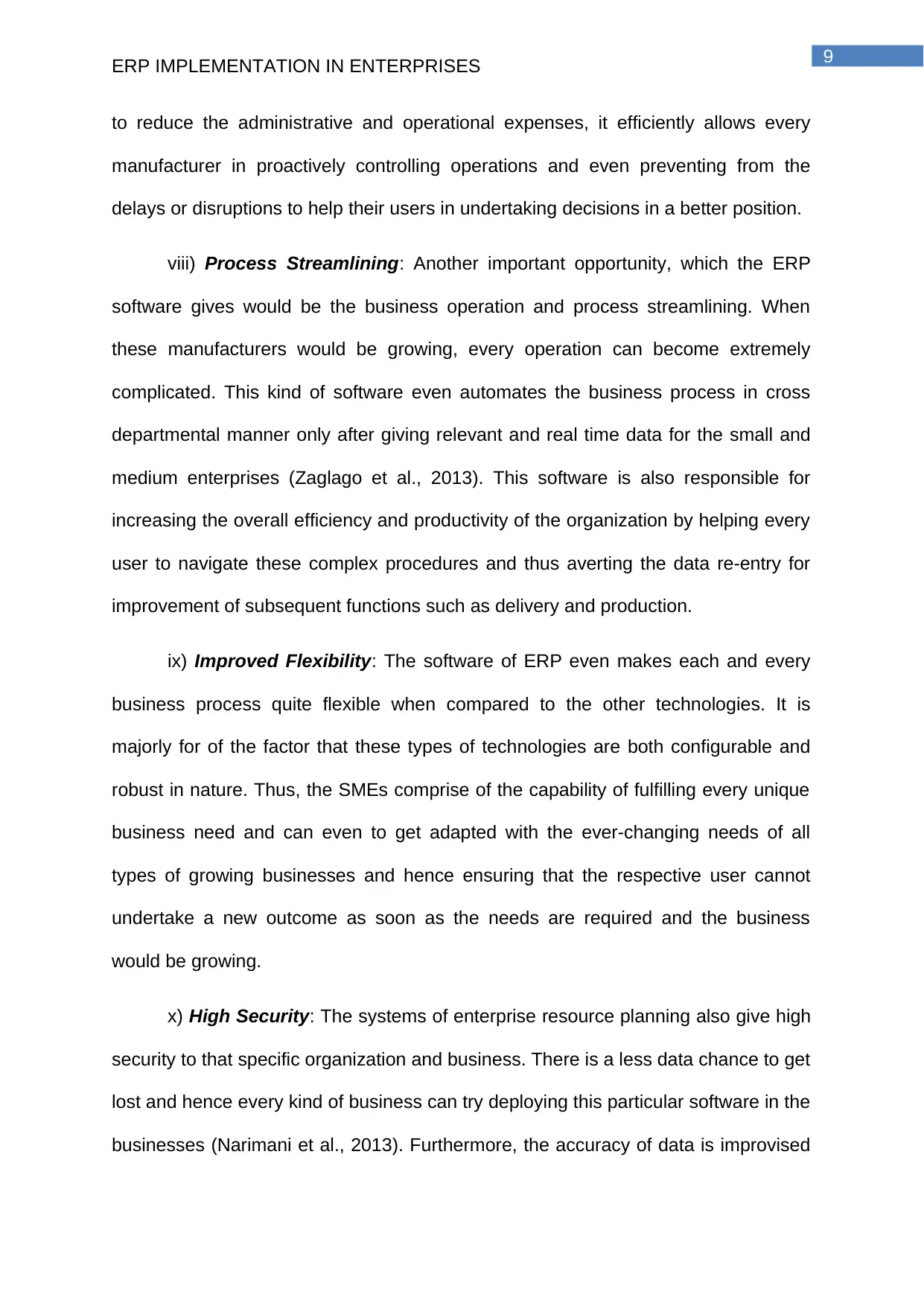
9
ERP IMPLEMENTATION IN ENTERPRISES
to reduce the administrative and operational expenses, it efficiently allows every
manufacturer in proactively controlling operations and even preventing from the
delays or disruptions to help their users in undertaking decisions in a better position.
viii) Process Streamlining: Another important opportunity, which the ERP
software gives would be the business operation and process streamlining. When
these manufacturers would be growing, every operation can become extremely
complicated. This kind of software even automates the business process in cross
departmental manner only after giving relevant and real time data for the small and
medium enterprises (Zaglago et al., 2013). This software is also responsible for
increasing the overall efficiency and productivity of the organization by helping every
user to navigate these complex procedures and thus averting the data re-entry for
improvement of subsequent functions such as delivery and production.
ix) Improved Flexibility: The software of ERP even makes each and every
business process quite flexible when compared to the other technologies. It is
majorly for of the factor that these types of technologies are both configurable and
robust in nature. Thus, the SMEs comprise of the capability of fulfilling every unique
business need and can even to get adapted with the ever-changing needs of all
types of growing businesses and hence ensuring that the respective user cannot
undertake a new outcome as soon as the needs are required and the business
would be growing.
x) High Security: The systems of enterprise resource planning also give high
security to that specific organization and business. There is a less data chance to get
lost and hence every kind of business can try deploying this particular software in the
businesses (Narimani et al., 2013). Furthermore, the accuracy of data is improvised
ERP IMPLEMENTATION IN ENTERPRISES
to reduce the administrative and operational expenses, it efficiently allows every
manufacturer in proactively controlling operations and even preventing from the
delays or disruptions to help their users in undertaking decisions in a better position.
viii) Process Streamlining: Another important opportunity, which the ERP
software gives would be the business operation and process streamlining. When
these manufacturers would be growing, every operation can become extremely
complicated. This kind of software even automates the business process in cross
departmental manner only after giving relevant and real time data for the small and
medium enterprises (Zaglago et al., 2013). This software is also responsible for
increasing the overall efficiency and productivity of the organization by helping every
user to navigate these complex procedures and thus averting the data re-entry for
improvement of subsequent functions such as delivery and production.
ix) Improved Flexibility: The software of ERP even makes each and every
business process quite flexible when compared to the other technologies. It is
majorly for of the factor that these types of technologies are both configurable and
robust in nature. Thus, the SMEs comprise of the capability of fulfilling every unique
business need and can even to get adapted with the ever-changing needs of all
types of growing businesses and hence ensuring that the respective user cannot
undertake a new outcome as soon as the needs are required and the business
would be growing.
x) High Security: The systems of enterprise resource planning also give high
security to that specific organization and business. There is a less data chance to get
lost and hence every kind of business can try deploying this particular software in the
businesses (Narimani et al., 2013). Furthermore, the accuracy of data is improvised
Secure Best Marks with AI Grader
Need help grading? Try our AI Grader for instant feedback on your assignments.
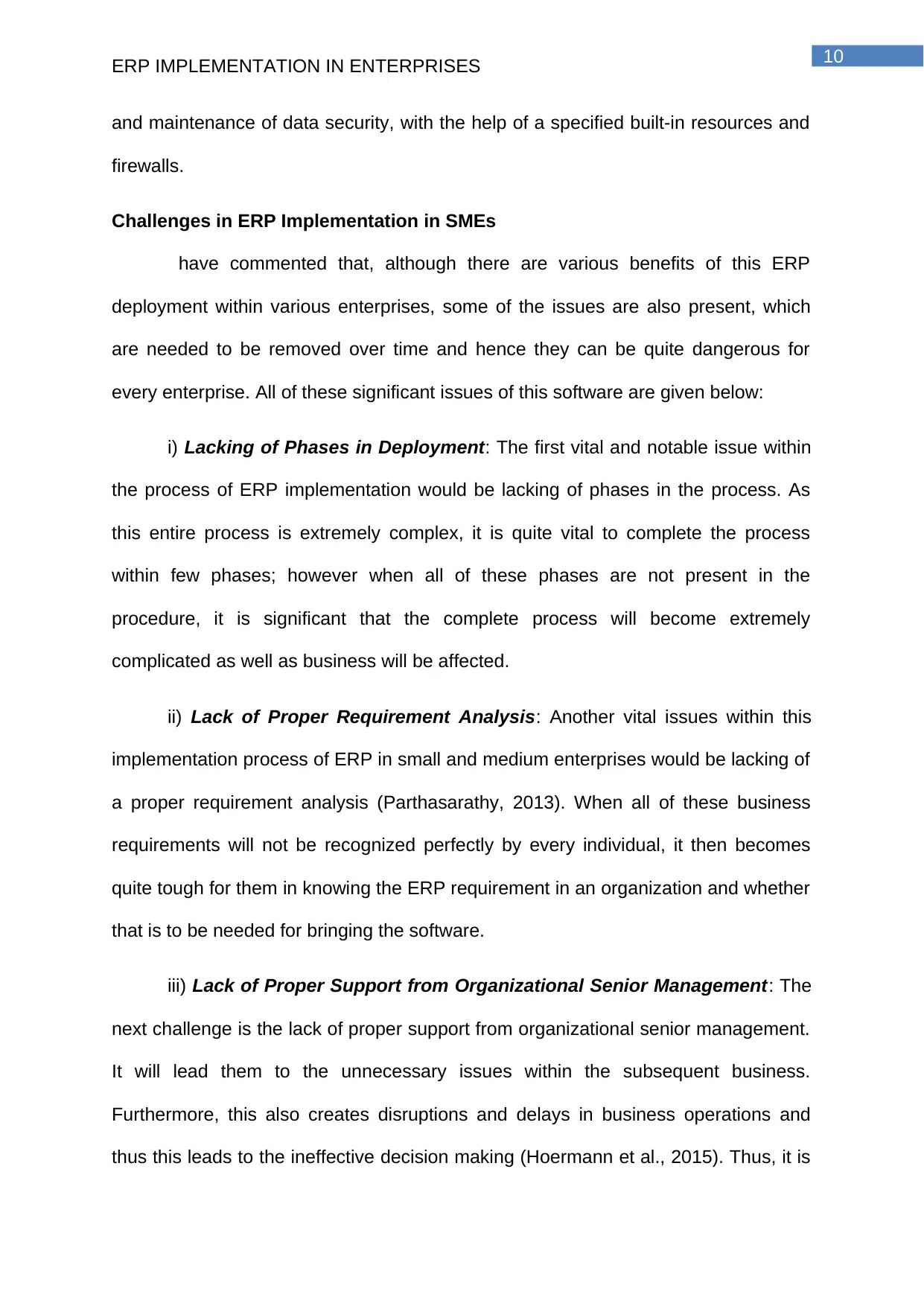
10
ERP IMPLEMENTATION IN ENTERPRISES
and maintenance of data security, with the help of a specified built-in resources and
firewalls.
Challenges in ERP Implementation in SMEs
have commented that, although there are various benefits of this ERP
deployment within various enterprises, some of the issues are also present, which
are needed to be removed over time and hence they can be quite dangerous for
every enterprise. All of these significant issues of this software are given below:
i) Lacking of Phases in Deployment: The first vital and notable issue within
the process of ERP implementation would be lacking of phases in the process. As
this entire process is extremely complex, it is quite vital to complete the process
within few phases; however when all of these phases are not present in the
procedure, it is significant that the complete process will become extremely
complicated as well as business will be affected.
ii) Lack of Proper Requirement Analysis: Another vital issues within this
implementation process of ERP in small and medium enterprises would be lacking of
a proper requirement analysis (Parthasarathy, 2013). When all of these business
requirements will not be recognized perfectly by every individual, it then becomes
quite tough for them in knowing the ERP requirement in an organization and whether
that is to be needed for bringing the software.
iii) Lack of Proper Support from Organizational Senior Management: The
next challenge is the lack of proper support from organizational senior management.
It will lead them to the unnecessary issues within the subsequent business.
Furthermore, this also creates disruptions and delays in business operations and
thus this leads to the ineffective decision making (Hoermann et al., 2015). Thus, it is
ERP IMPLEMENTATION IN ENTERPRISES
and maintenance of data security, with the help of a specified built-in resources and
firewalls.
Challenges in ERP Implementation in SMEs
have commented that, although there are various benefits of this ERP
deployment within various enterprises, some of the issues are also present, which
are needed to be removed over time and hence they can be quite dangerous for
every enterprise. All of these significant issues of this software are given below:
i) Lacking of Phases in Deployment: The first vital and notable issue within
the process of ERP implementation would be lacking of phases in the process. As
this entire process is extremely complex, it is quite vital to complete the process
within few phases; however when all of these phases are not present in the
procedure, it is significant that the complete process will become extremely
complicated as well as business will be affected.
ii) Lack of Proper Requirement Analysis: Another vital issues within this
implementation process of ERP in small and medium enterprises would be lacking of
a proper requirement analysis (Parthasarathy, 2013). When all of these business
requirements will not be recognized perfectly by every individual, it then becomes
quite tough for them in knowing the ERP requirement in an organization and whether
that is to be needed for bringing the software.
iii) Lack of Proper Support from Organizational Senior Management: The
next challenge is the lack of proper support from organizational senior management.
It will lead them to the unnecessary issues within the subsequent business.
Furthermore, this also creates disruptions and delays in business operations and
thus this leads to the ineffective decision making (Hoermann et al., 2015). Thus, it is
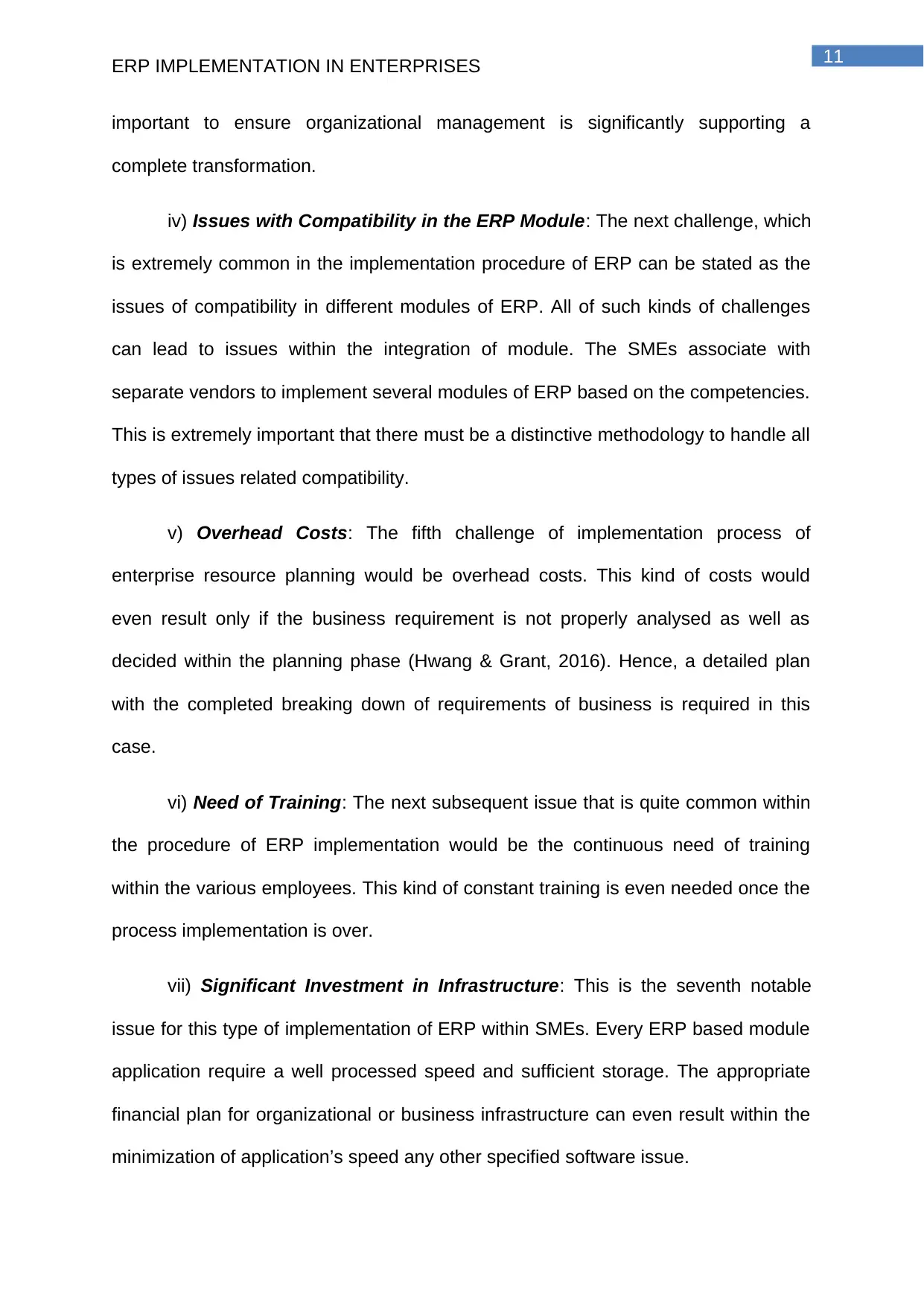
11
ERP IMPLEMENTATION IN ENTERPRISES
important to ensure organizational management is significantly supporting a
complete transformation.
iv) Issues with Compatibility in the ERP Module: The next challenge, which
is extremely common in the implementation procedure of ERP can be stated as the
issues of compatibility in different modules of ERP. All of such kinds of challenges
can lead to issues within the integration of module. The SMEs associate with
separate vendors to implement several modules of ERP based on the competencies.
This is extremely important that there must be a distinctive methodology to handle all
types of issues related compatibility.
v) Overhead Costs: The fifth challenge of implementation process of
enterprise resource planning would be overhead costs. This kind of costs would
even result only if the business requirement is not properly analysed as well as
decided within the planning phase (Hwang & Grant, 2016). Hence, a detailed plan
with the completed breaking down of requirements of business is required in this
case.
vi) Need of Training: The next subsequent issue that is quite common within
the procedure of ERP implementation would be the continuous need of training
within the various employees. This kind of constant training is even needed once the
process implementation is over.
vii) Significant Investment in Infrastructure: This is the seventh notable
issue for this type of implementation of ERP within SMEs. Every ERP based module
application require a well processed speed and sufficient storage. The appropriate
financial plan for organizational or business infrastructure can even result within the
minimization of application’s speed any other specified software issue.
ERP IMPLEMENTATION IN ENTERPRISES
important to ensure organizational management is significantly supporting a
complete transformation.
iv) Issues with Compatibility in the ERP Module: The next challenge, which
is extremely common in the implementation procedure of ERP can be stated as the
issues of compatibility in different modules of ERP. All of such kinds of challenges
can lead to issues within the integration of module. The SMEs associate with
separate vendors to implement several modules of ERP based on the competencies.
This is extremely important that there must be a distinctive methodology to handle all
types of issues related compatibility.
v) Overhead Costs: The fifth challenge of implementation process of
enterprise resource planning would be overhead costs. This kind of costs would
even result only if the business requirement is not properly analysed as well as
decided within the planning phase (Hwang & Grant, 2016). Hence, a detailed plan
with the completed breaking down of requirements of business is required in this
case.
vi) Need of Training: The next subsequent issue that is quite common within
the procedure of ERP implementation would be the continuous need of training
within the various employees. This kind of constant training is even needed once the
process implementation is over.
vii) Significant Investment in Infrastructure: This is the seventh notable
issue for this type of implementation of ERP within SMEs. Every ERP based module
application require a well processed speed and sufficient storage. The appropriate
financial plan for organizational or business infrastructure can even result within the
minimization of application’s speed any other specified software issue.
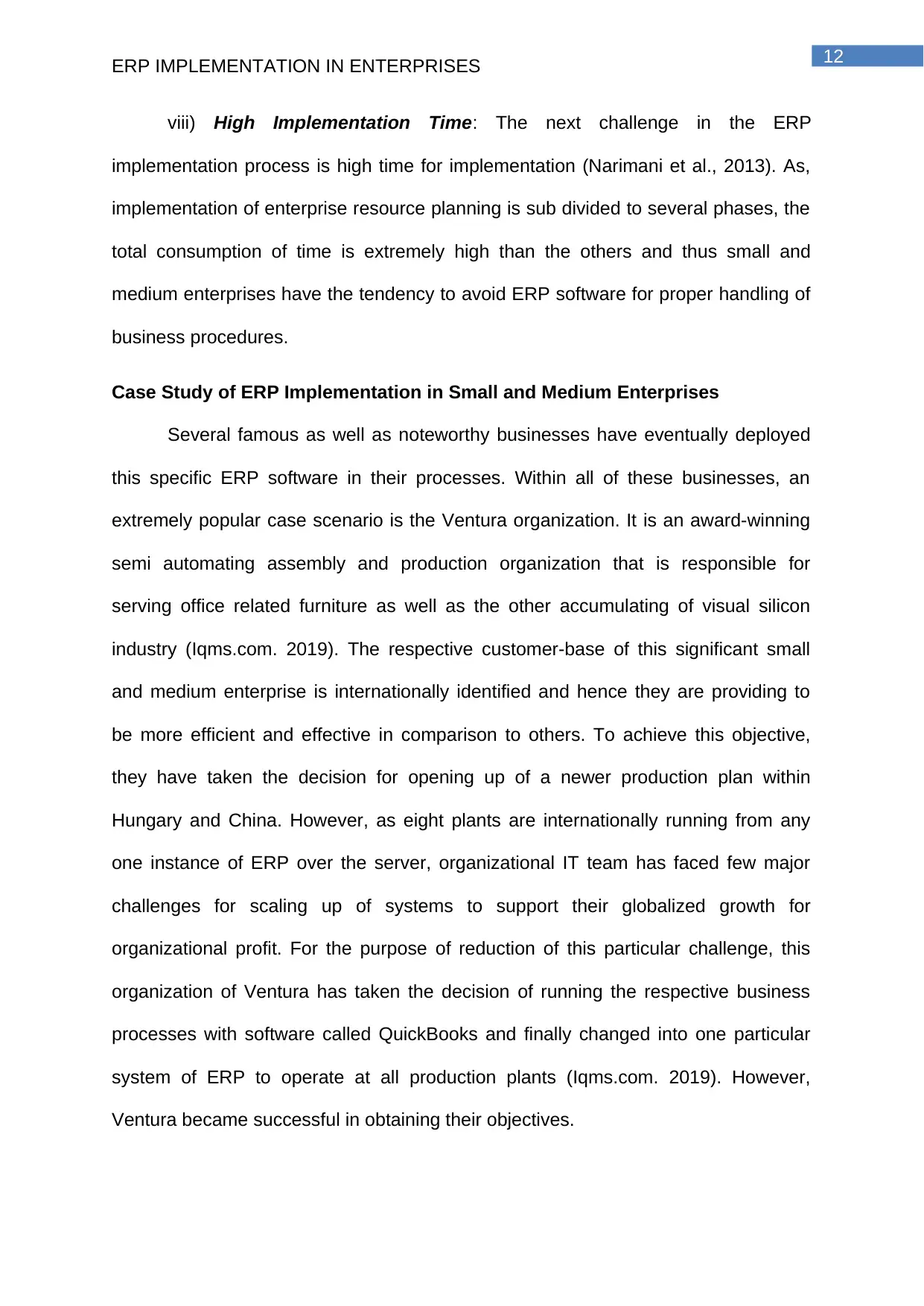
12
ERP IMPLEMENTATION IN ENTERPRISES
viii) High Implementation Time: The next challenge in the ERP
implementation process is high time for implementation (Narimani et al., 2013). As,
implementation of enterprise resource planning is sub divided to several phases, the
total consumption of time is extremely high than the others and thus small and
medium enterprises have the tendency to avoid ERP software for proper handling of
business procedures.
Case Study of ERP Implementation in Small and Medium Enterprises
Several famous as well as noteworthy businesses have eventually deployed
this specific ERP software in their processes. Within all of these businesses, an
extremely popular case scenario is the Ventura organization. It is an award-winning
semi automating assembly and production organization that is responsible for
serving office related furniture as well as the other accumulating of visual silicon
industry (Iqms.com. 2019). The respective customer-base of this significant small
and medium enterprise is internationally identified and hence they are providing to
be more efficient and effective in comparison to others. To achieve this objective,
they have taken the decision for opening up of a newer production plan within
Hungary and China. However, as eight plants are internationally running from any
one instance of ERP over the server, organizational IT team has faced few major
challenges for scaling up of systems to support their globalized growth for
organizational profit. For the purpose of reduction of this particular challenge, this
organization of Ventura has taken the decision of running the respective business
processes with software called QuickBooks and finally changed into one particular
system of ERP to operate at all production plants (Iqms.com. 2019). However,
Ventura became successful in obtaining their objectives.
ERP IMPLEMENTATION IN ENTERPRISES
viii) High Implementation Time: The next challenge in the ERP
implementation process is high time for implementation (Narimani et al., 2013). As,
implementation of enterprise resource planning is sub divided to several phases, the
total consumption of time is extremely high than the others and thus small and
medium enterprises have the tendency to avoid ERP software for proper handling of
business procedures.
Case Study of ERP Implementation in Small and Medium Enterprises
Several famous as well as noteworthy businesses have eventually deployed
this specific ERP software in their processes. Within all of these businesses, an
extremely popular case scenario is the Ventura organization. It is an award-winning
semi automating assembly and production organization that is responsible for
serving office related furniture as well as the other accumulating of visual silicon
industry (Iqms.com. 2019). The respective customer-base of this significant small
and medium enterprise is internationally identified and hence they are providing to
be more efficient and effective in comparison to others. To achieve this objective,
they have taken the decision for opening up of a newer production plan within
Hungary and China. However, as eight plants are internationally running from any
one instance of ERP over the server, organizational IT team has faced few major
challenges for scaling up of systems to support their globalized growth for
organizational profit. For the purpose of reduction of this particular challenge, this
organization of Ventura has taken the decision of running the respective business
processes with software called QuickBooks and finally changed into one particular
system of ERP to operate at all production plants (Iqms.com. 2019). However,
Ventura became successful in obtaining their objectives.
Paraphrase This Document
Need a fresh take? Get an instant paraphrase of this document with our AI Paraphraser
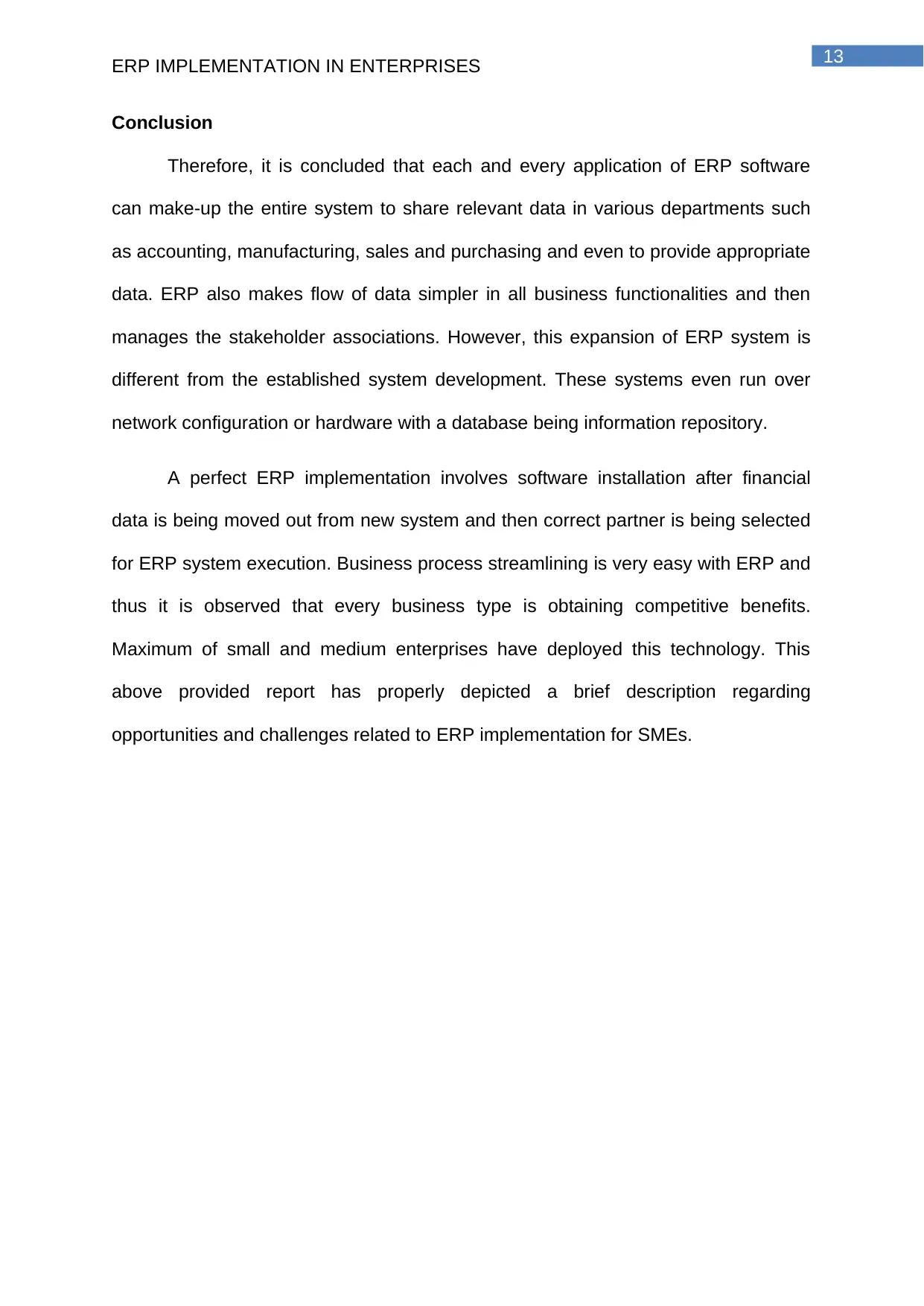
13
ERP IMPLEMENTATION IN ENTERPRISES
Conclusion
Therefore, it is concluded that each and every application of ERP software
can make-up the entire system to share relevant data in various departments such
as accounting, manufacturing, sales and purchasing and even to provide appropriate
data. ERP also makes flow of data simpler in all business functionalities and then
manages the stakeholder associations. However, this expansion of ERP system is
different from the established system development. These systems even run over
network configuration or hardware with a database being information repository.
A perfect ERP implementation involves software installation after financial
data is being moved out from new system and then correct partner is being selected
for ERP system execution. Business process streamlining is very easy with ERP and
thus it is observed that every business type is obtaining competitive benefits.
Maximum of small and medium enterprises have deployed this technology. This
above provided report has properly depicted a brief description regarding
opportunities and challenges related to ERP implementation for SMEs.
ERP IMPLEMENTATION IN ENTERPRISES
Conclusion
Therefore, it is concluded that each and every application of ERP software
can make-up the entire system to share relevant data in various departments such
as accounting, manufacturing, sales and purchasing and even to provide appropriate
data. ERP also makes flow of data simpler in all business functionalities and then
manages the stakeholder associations. However, this expansion of ERP system is
different from the established system development. These systems even run over
network configuration or hardware with a database being information repository.
A perfect ERP implementation involves software installation after financial
data is being moved out from new system and then correct partner is being selected
for ERP system execution. Business process streamlining is very easy with ERP and
thus it is observed that every business type is obtaining competitive benefits.
Maximum of small and medium enterprises have deployed this technology. This
above provided report has properly depicted a brief description regarding
opportunities and challenges related to ERP implementation for SMEs.
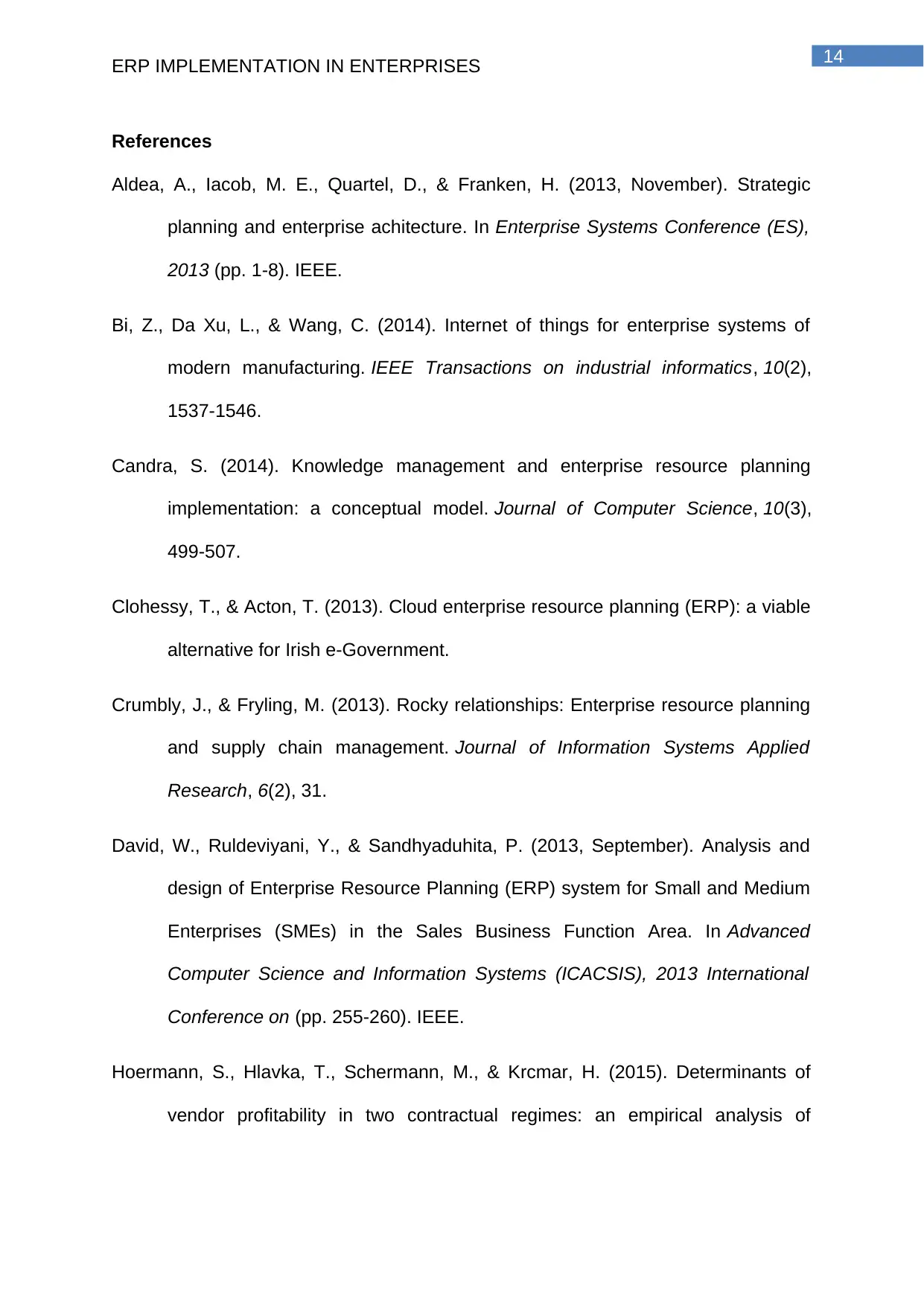
14
ERP IMPLEMENTATION IN ENTERPRISES
References
Aldea, A., Iacob, M. E., Quartel, D., & Franken, H. (2013, November). Strategic
planning and enterprise achitecture. In Enterprise Systems Conference (ES),
2013 (pp. 1-8). IEEE.
Bi, Z., Da Xu, L., & Wang, C. (2014). Internet of things for enterprise systems of
modern manufacturing. IEEE Transactions on industrial informatics, 10(2),
1537-1546.
Candra, S. (2014). Knowledge management and enterprise resource planning
implementation: a conceptual model. Journal of Computer Science, 10(3),
499-507.
Clohessy, T., & Acton, T. (2013). Cloud enterprise resource planning (ERP): a viable
alternative for Irish e-Government.
Crumbly, J., & Fryling, M. (2013). Rocky relationships: Enterprise resource planning
and supply chain management. Journal of Information Systems Applied
Research, 6(2), 31.
David, W., Ruldeviyani, Y., & Sandhyaduhita, P. (2013, September). Analysis and
design of Enterprise Resource Planning (ERP) system for Small and Medium
Enterprises (SMEs) in the Sales Business Function Area. In Advanced
Computer Science and Information Systems (ICACSIS), 2013 International
Conference on (pp. 255-260). IEEE.
Hoermann, S., Hlavka, T., Schermann, M., & Krcmar, H. (2015). Determinants of
vendor profitability in two contractual regimes: an empirical analysis of
ERP IMPLEMENTATION IN ENTERPRISES
References
Aldea, A., Iacob, M. E., Quartel, D., & Franken, H. (2013, November). Strategic
planning and enterprise achitecture. In Enterprise Systems Conference (ES),
2013 (pp. 1-8). IEEE.
Bi, Z., Da Xu, L., & Wang, C. (2014). Internet of things for enterprise systems of
modern manufacturing. IEEE Transactions on industrial informatics, 10(2),
1537-1546.
Candra, S. (2014). Knowledge management and enterprise resource planning
implementation: a conceptual model. Journal of Computer Science, 10(3),
499-507.
Clohessy, T., & Acton, T. (2013). Cloud enterprise resource planning (ERP): a viable
alternative for Irish e-Government.
Crumbly, J., & Fryling, M. (2013). Rocky relationships: Enterprise resource planning
and supply chain management. Journal of Information Systems Applied
Research, 6(2), 31.
David, W., Ruldeviyani, Y., & Sandhyaduhita, P. (2013, September). Analysis and
design of Enterprise Resource Planning (ERP) system for Small and Medium
Enterprises (SMEs) in the Sales Business Function Area. In Advanced
Computer Science and Information Systems (ICACSIS), 2013 International
Conference on (pp. 255-260). IEEE.
Hoermann, S., Hlavka, T., Schermann, M., & Krcmar, H. (2015). Determinants of
vendor profitability in two contractual regimes: an empirical analysis of
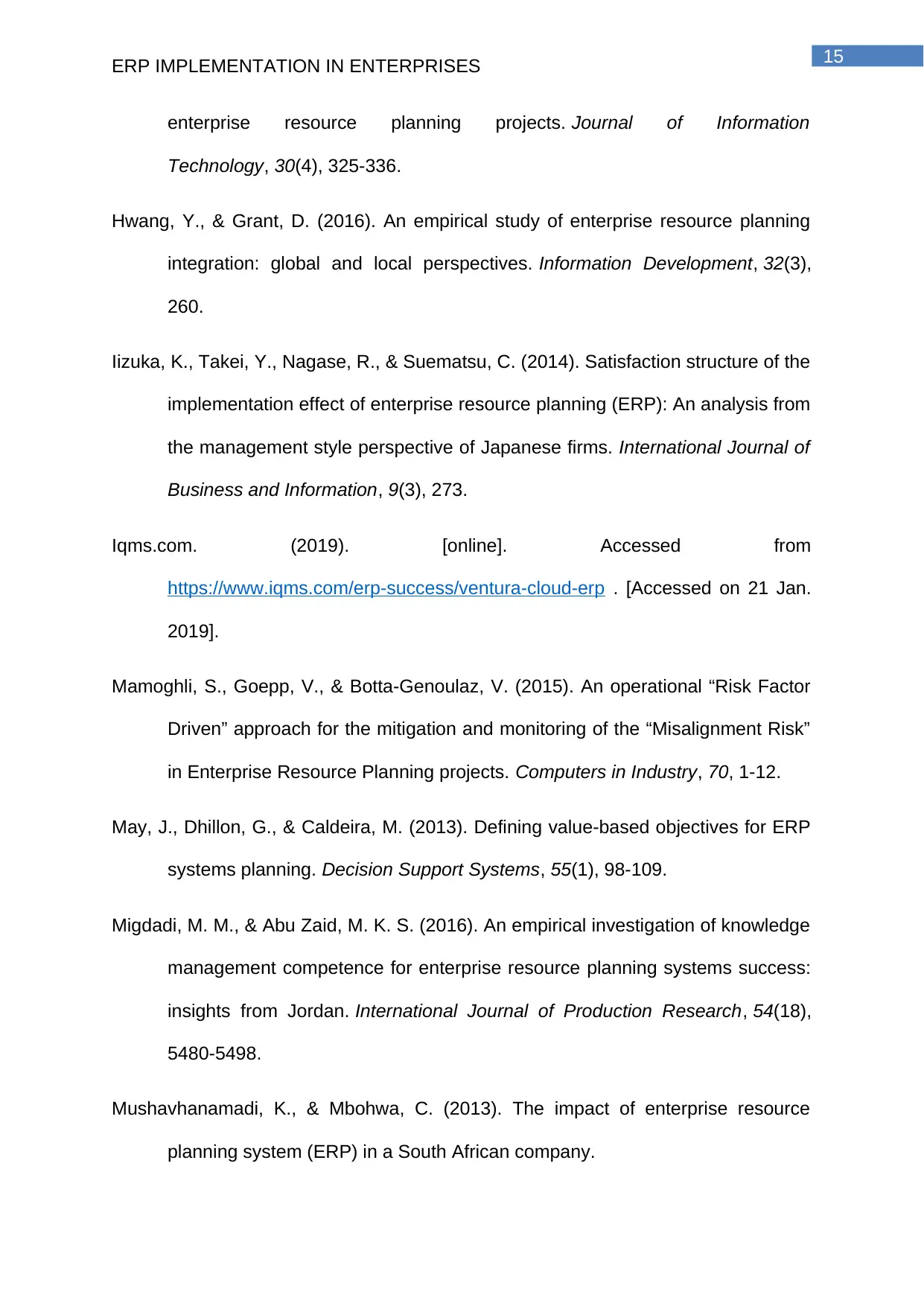
15
ERP IMPLEMENTATION IN ENTERPRISES
enterprise resource planning projects. Journal of Information
Technology, 30(4), 325-336.
Hwang, Y., & Grant, D. (2016). An empirical study of enterprise resource planning
integration: global and local perspectives. Information Development, 32(3),
260.
Iizuka, K., Takei, Y., Nagase, R., & Suematsu, C. (2014). Satisfaction structure of the
implementation effect of enterprise resource planning (ERP): An analysis from
the management style perspective of Japanese firms. International Journal of
Business and Information, 9(3), 273.
Iqms.com. (2019). [online]. Accessed from
https://www.iqms.com/erp-success/ventura-cloud-erp . [Accessed on 21 Jan.
2019].
Mamoghli, S., Goepp, V., & Botta-Genoulaz, V. (2015). An operational “Risk Factor
Driven” approach for the mitigation and monitoring of the “Misalignment Risk”
in Enterprise Resource Planning projects. Computers in Industry, 70, 1-12.
May, J., Dhillon, G., & Caldeira, M. (2013). Defining value-based objectives for ERP
systems planning. Decision Support Systems, 55(1), 98-109.
Migdadi, M. M., & Abu Zaid, M. K. S. (2016). An empirical investigation of knowledge
management competence for enterprise resource planning systems success:
insights from Jordan. International Journal of Production Research, 54(18),
5480-5498.
Mushavhanamadi, K., & Mbohwa, C. (2013). The impact of enterprise resource
planning system (ERP) in a South African company.
ERP IMPLEMENTATION IN ENTERPRISES
enterprise resource planning projects. Journal of Information
Technology, 30(4), 325-336.
Hwang, Y., & Grant, D. (2016). An empirical study of enterprise resource planning
integration: global and local perspectives. Information Development, 32(3),
260.
Iizuka, K., Takei, Y., Nagase, R., & Suematsu, C. (2014). Satisfaction structure of the
implementation effect of enterprise resource planning (ERP): An analysis from
the management style perspective of Japanese firms. International Journal of
Business and Information, 9(3), 273.
Iqms.com. (2019). [online]. Accessed from
https://www.iqms.com/erp-success/ventura-cloud-erp . [Accessed on 21 Jan.
2019].
Mamoghli, S., Goepp, V., & Botta-Genoulaz, V. (2015). An operational “Risk Factor
Driven” approach for the mitigation and monitoring of the “Misalignment Risk”
in Enterprise Resource Planning projects. Computers in Industry, 70, 1-12.
May, J., Dhillon, G., & Caldeira, M. (2013). Defining value-based objectives for ERP
systems planning. Decision Support Systems, 55(1), 98-109.
Migdadi, M. M., & Abu Zaid, M. K. S. (2016). An empirical investigation of knowledge
management competence for enterprise resource planning systems success:
insights from Jordan. International Journal of Production Research, 54(18),
5480-5498.
Mushavhanamadi, K., & Mbohwa, C. (2013). The impact of enterprise resource
planning system (ERP) in a South African company.
Secure Best Marks with AI Grader
Need help grading? Try our AI Grader for instant feedback on your assignments.
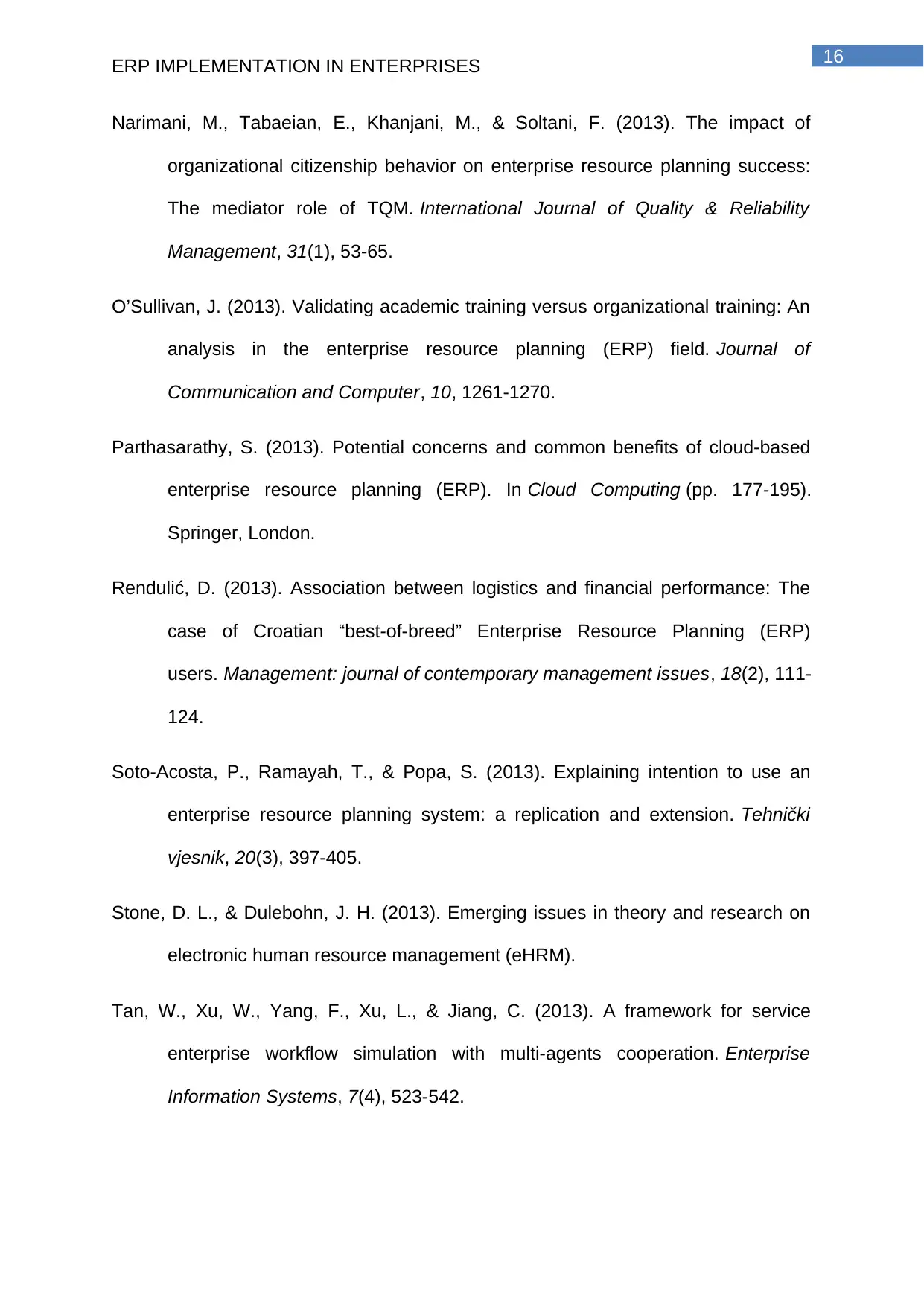
16
ERP IMPLEMENTATION IN ENTERPRISES
Narimani, M., Tabaeian, E., Khanjani, M., & Soltani, F. (2013). The impact of
organizational citizenship behavior on enterprise resource planning success:
The mediator role of TQM. International Journal of Quality & Reliability
Management, 31(1), 53-65.
O’Sullivan, J. (2013). Validating academic training versus organizational training: An
analysis in the enterprise resource planning (ERP) field. Journal of
Communication and Computer, 10, 1261-1270.
Parthasarathy, S. (2013). Potential concerns and common benefits of cloud-based
enterprise resource planning (ERP). In Cloud Computing (pp. 177-195).
Springer, London.
Rendulić, D. (2013). Association between logistics and financial performance: The
case of Croatian “best-of-breed” Enterprise Resource Planning (ERP)
users. Management: journal of contemporary management issues, 18(2), 111-
124.
Soto-Acosta, P., Ramayah, T., & Popa, S. (2013). Explaining intention to use an
enterprise resource planning system: a replication and extension. Tehnički
vjesnik, 20(3), 397-405.
Stone, D. L., & Dulebohn, J. H. (2013). Emerging issues in theory and research on
electronic human resource management (eHRM).
Tan, W., Xu, W., Yang, F., Xu, L., & Jiang, C. (2013). A framework for service
enterprise workflow simulation with multi-agents cooperation. Enterprise
Information Systems, 7(4), 523-542.
ERP IMPLEMENTATION IN ENTERPRISES
Narimani, M., Tabaeian, E., Khanjani, M., & Soltani, F. (2013). The impact of
organizational citizenship behavior on enterprise resource planning success:
The mediator role of TQM. International Journal of Quality & Reliability
Management, 31(1), 53-65.
O’Sullivan, J. (2013). Validating academic training versus organizational training: An
analysis in the enterprise resource planning (ERP) field. Journal of
Communication and Computer, 10, 1261-1270.
Parthasarathy, S. (2013). Potential concerns and common benefits of cloud-based
enterprise resource planning (ERP). In Cloud Computing (pp. 177-195).
Springer, London.
Rendulić, D. (2013). Association between logistics and financial performance: The
case of Croatian “best-of-breed” Enterprise Resource Planning (ERP)
users. Management: journal of contemporary management issues, 18(2), 111-
124.
Soto-Acosta, P., Ramayah, T., & Popa, S. (2013). Explaining intention to use an
enterprise resource planning system: a replication and extension. Tehnički
vjesnik, 20(3), 397-405.
Stone, D. L., & Dulebohn, J. H. (2013). Emerging issues in theory and research on
electronic human resource management (eHRM).
Tan, W., Xu, W., Yang, F., Xu, L., & Jiang, C. (2013). A framework for service
enterprise workflow simulation with multi-agents cooperation. Enterprise
Information Systems, 7(4), 523-542.
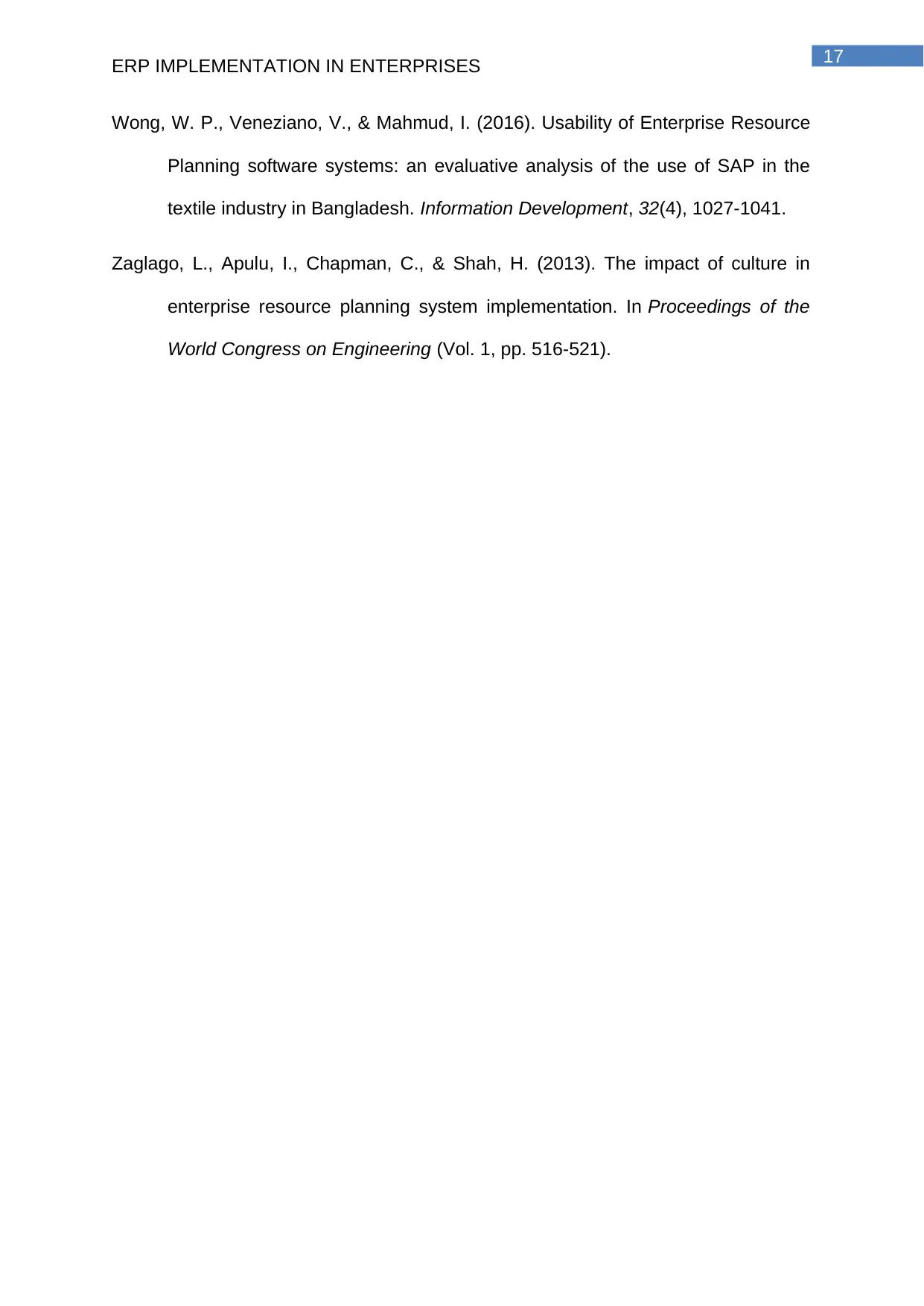
17
ERP IMPLEMENTATION IN ENTERPRISES
Wong, W. P., Veneziano, V., & Mahmud, I. (2016). Usability of Enterprise Resource
Planning software systems: an evaluative analysis of the use of SAP in the
textile industry in Bangladesh. Information Development, 32(4), 1027-1041.
Zaglago, L., Apulu, I., Chapman, C., & Shah, H. (2013). The impact of culture in
enterprise resource planning system implementation. In Proceedings of the
World Congress on Engineering (Vol. 1, pp. 516-521).
ERP IMPLEMENTATION IN ENTERPRISES
Wong, W. P., Veneziano, V., & Mahmud, I. (2016). Usability of Enterprise Resource
Planning software systems: an evaluative analysis of the use of SAP in the
textile industry in Bangladesh. Information Development, 32(4), 1027-1041.
Zaglago, L., Apulu, I., Chapman, C., & Shah, H. (2013). The impact of culture in
enterprise resource planning system implementation. In Proceedings of the
World Congress on Engineering (Vol. 1, pp. 516-521).
1 out of 18
Related Documents
Your All-in-One AI-Powered Toolkit for Academic Success.
+13062052269
info@desklib.com
Available 24*7 on WhatsApp / Email
![[object Object]](/_next/static/media/star-bottom.7253800d.svg)
Unlock your academic potential
© 2024 | Zucol Services PVT LTD | All rights reserved.





